13.1: Education and the Global Perspective
13.1.1: Education and the Global Perspective
In today’s world, some degree of education is necessary for people in most countries.
Learning Objective
Discuss recent worldwide trends in education, including mass schooling, the emergence of secondary education in the U.S., indigenous education, higher education, and online learning
Key Points
- Education is the means through which the aims and habits of a group of people are passed from one generation to the next.
- Location contributes to a child’s lack of access to primary education. In certain areas of the world, children have difficulty getting to school.
- Gender often factors into a child’s access to education.
- Costs contribute to a child’s lack of access to primary education. High opportunity costs are often influential in the decision to attend school.
- Mass schooling has perpetuated the idea that everyone has a right to be educated regardless of his/her cultural background and gender.
- A lack of access to education is one of the primary barriers to human development.
Key Terms
- Internationalization of Education
-
The increased emphasis on international cultural exchange in the course of education.
- Mass Schooling
-
The phenomenon that describes the rise in school attendance worldwide.
Examples
- UNESCO has found that the number of children enrolled in primary schools worldwide rose by more than 40 million between 1999 and 2007. The net primary enrollment in sub-Saharan Africa rose from 58% to 74% over the same period, and international aid commitments to basic education almost doubled from $2.1 billion in 2002 to $4.1 billion in 2007.
- Currently, there are more than 75 million children around the world of primary school age who are not in school. The majority of these children are in regions of sub-Saharan Africa and South Asia. Within these regions, girls are at the greatest disadvantage in receiving access to education at the primary school age.
- There is currently a gender discrepancy in education. Enrollment is low for both boys and girls in sub-Saharan Africa, with rates of just 27% and 22%. Today some 78% of girls drop out of school, compared with 48% of boys. Therefore, child’s gender continues to contribute to access and attendance today.
- High opportunity costs are often influential in the decision to attend school. For example, according to UNICEF, an estimated 121 million children of primary-school age are being kept out of school to work in the fields or at home.
- Education is becoming increasingly international. In Europe, for example, the Socrates-Erasmus Program stimulates exchanges across European universities. Also, the Soros Foundation provides many opportunities for students from central Asia and Eastern Europe.
Education Today
In today’s world, some degree of education is necessary for people in most countries. Due to population growth and the proliferation of compulsory education, UNESCO has calculated that in the next 30 years, more people will receive formal education than in any prior period of human history. In fact, illiteracy and the percentage of populations without any schooling have already decreased, from 36% in 1960 to 25% in 2000.
Education in its broadest, most general sense is a means through which the aims and habits of a group of people is passed from one generation to the next. Generally, education results from any experience that affects the way in which one thinks, feels, or acts. In its narrowest, most technical sense, education is the formal process (e.g., instruction in schools) by which society deliberately passes accumulated knowledge, skills, customs, and values from one generation to the next.
Education in the Developing World
India is developing technologies that bypass land-based telephone and internet lines. The country recently launched EDUSAT, an education satellite that can reach a great number of people at a significantly reduced cost. Another initiative, started by the OLPC foundation, involving a group from the MIT Media Lab, and supported by several major corporations, has developed a $100 laptop for the delivery of educational programs. As of 2008, the laptops were already widely available.
In Africa, the New Partnership for Africa’s Development (NEPAD) has launched an e-school program. The goal is to provide 600,000 primary and high schools with computer equipment, learning materials, and internet access within 10 years. Private groups, like Church of Jesus Christ of Latter-day Saints, are also working to improve access to education through such programs as the Perpetual Education Fund.
Internationalization (Globalization and Education)
Education is becoming increasingly international, and mass schooling has promoted the fundamental idea that everyone has a right to be educated regardless of his/her cultural background. In Europe, for example, the Socrates-Erasmus Program fosters exchanges between European universities, while the Soros Foundation provides educational opportunities to students from central Asia and eastern Europe. Programs such as the International Baccalaureate have also contributed to the internationalization of education. Some scholars argue that, regardless of the perceived quality of different educational systems, experiencing a different system of education can be an important and enriching aspect of an international learning experience. Meanwhile, the global online campus, led by American universities, has promoted free access to class materials and lectures recorded during actual classes. This project further facilitates the globalization of education.
Recent Worldwide Trends
The emergence of secondary education in the United States did not occur until 1910, when a rise in big business and technological advances in factories (for instance, the emergence of electrification) required skilled workers. In order to meet new job requirements, high schools were created with curriculums focused on practical job skills that would prepare students for white- or blue-collar work. This emerging system proved to be beneficial for both the employer and the employee; improved job skills increased efficiency and lowered costs for employers, while skilled employees received higher wages.
Indigenous education refers to the inclusion of indigenous knowledge, models, methods, and content within formal and non-formal educational systems. Often in a post-colonial context, the growing recognition and use of indigenous education methods has been a response to the erosion and loss of indigenous knowledge and language through earlier processes of colonialism. It has also enabled indigenous communities to strengthen links to their traditional languages and cultures, a process that has also been linked to increased academic success.
Higher education generally involves work towards a degree-level or foundation degree qualification. In most developed countries, a high proportion of the population (up to 50%) now obtain higher education at some point in their lives. Higher education is therefore important to national economies as both a significant industry in its own right and a source of trained and educated personnel.
As a result of the Internet, higher education is increasingly open and accessible. Online learning gives students flexibility and choice in terms of what, when, and at what pace they learn. Many universities and organizations are creating open educational resources that self-motivated students can access anywhere and at any time. Unlike traditional forms of higher education, open, online education generally does not take the form of recognized degree programs.
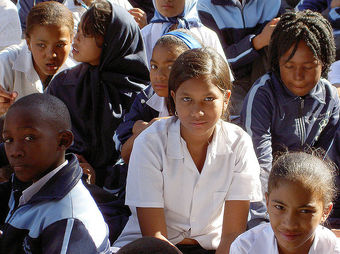
Education in South Africa
School children at Imperial Primary School in Eastridge, Mitchell’s Plain (Cape Town, South Africa)
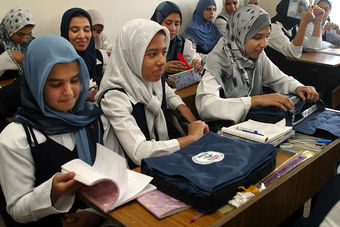
Education in the Middle East
Students from the Hala Bint Khuwaylid secondary girl’s school in the Amil district of Baghdad, pictured with new school bags containing pens, pencils, notebooks, calculators, and other school supplies: USAID is funding the purchase and distribution of 1.5 million school bags through a partnership with Creative Associates International. All Iraqi secondary students will receive bags.
13.1.2: Education and Industrialization
It has been argued that high rates of education are essential for countries to be able to achieve high levels of economic growth.
Learning Objective
Define education economics, human capital, human capital flight, and educational technology
Key Points
- In the developing world, there is economic pressure from those parents who prioritize sending their children to work to make money in the short term over any long-term benefits of education.
- Education economics is the study of economic issues relating to education, including the demand for education and the financing and provision of education.
- The central idea of human capital is that undertaking education is investment in the acquisition of skills and knowledge which will increase earnings.
- Human capital flight, more commonly referred to as the “brain drain,” is the large-scale emigration of a large group of individuals with technical skills or knowledge.
- Educational technology is the study and ethical practice of facilitating learning and improving performance by creating, using, and managing appropriate technological processes and resources.
Key Terms
- human capital
-
The stock of competencies, knowledge, social, and personality attributes, including creativity, embodied in the ability to perform labor so as to produce economic value.
- brain drain
-
The migration of educated or talented people from less- economically advanced areas to more economically advanced areas, especially to large cities or richer countries.
- Education Economics
-
The study of economic issues relating to education, including the demand for education and the financing and provision of education.
Example
- There are various types of technologies currently used in traditional classrooms. Among these are computers in the classroom, a website for every class, class blogs and wikis, wireless classroom microphones, online media, and interactive whiteboards.
In developing countries, the number and seriousness of the problems faced is naturally greater. People are sometimes unaware of the importance of education, and there is economic pressure from those parents who prioritize their children’s making money in the short term over any long-term benefits of education. Recent studies on child labor and poverty have suggested, however, that when poor families reach a certain economic threshold where families are able to provide for their basic needs, parents return their children to school. This has been found to be true, once the threshold has been breached, even if the potential economic value of the children’s work has increased since their return to school.
Education and Economic Growth
It has been argued that high rates of education are essential for countries to be able to achieve high levels of economic growth. Empirical analyses tend to support the theoretical prediction that poor countries should grow faster than rich countries because they can adopt cutting edge technologies already tried and tested by rich countries. Education economics is the study of economic issues relating to education, including the demand for education and the financing and provision of education. The dominant model of the demand for education is based on human capital theory. The central idea is that undertaking education is investment in the acquisition of skills and knowledge, which will increase earnings or provide long-term benefits, such as an appreciation of literature. An increase in human capital can follow technological progress as knowledgeable employees are in demand due to the need for their skills, whether it be in understanding the production process or in operating machines. Human capital flight, more commonly referred to as the “brain drain,” is the large-scale emigration of a large group of individuals with technical skills or knowledge. The reasons usually include two aspects which respectively come from countries and individuals. The brain drain is often associated with de-skilling of emigrants in their country of destination, while their country of emigration experiences the draining of skilled individuals.
Educational Technology
Educational technology is the study and ethical practice of facilitating learning and improving performance by creating, using, and managing appropriate technological processes and resources. Technology of education is most simply and comfortably defined as an array of tools that might prove helpful in advancing student learning and may be measured in how and why individuals behave. There are various types of technologies currently used in traditional classrooms. Among these are computers in the classroom; a website for every class; class blogs and wikis; wireless classroom microphones; and online media and interactive whiteboards.
Educational technology is intended to improve education over what it would be without technology. Its benefits include easy-to-access course materials; increased student motivation; improved student writing; subjects made easier to learn; and differentiated instruction.
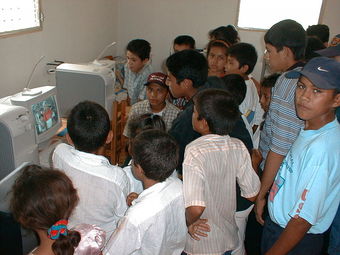
Education Technology
There are various types of technologies currently used in traditional classrooms. Having a computer in the classroom is an asset to any teacher. With a computer in the classroom, teachers are able to demonstrate a new lesson, present new material, illustrate how to use new programs, and show new websites
13.1.3: Education and Liberty in the Developing World
A lack of access to education is one of the primary limits on human development.
Learning Objective
Discuss the factors that impact education in societies worldwide
Key Points
- International development is a concept that refers to the development of greater quality of life for humanity.
- In 2000, the United Nations signed the United Nations Millennium Declaration, which includes eight Millennium Development Goals to be achieved by 2015 or 2020, one of which is Universal Primary Education.
- Location contributes to a child’s lack of access and attendance to primary education. In certain areas of the world, it is more difficult for children to get to school.
- Gender contributes to a child’s lack of access and attendance to education.
- Costs contribute to a child’s lack of access and attendance to primary education. High opportunity costs are often influential in the decision to attend school.
Key Terms
- Universal Primary Education
-
One of the eight Millennium Development Goals developed by the United Nations; An attempt to give all primary school aged children access to education.
- Internationalization of Education
-
The increased emphasis on international cultural exchange in the course of education.
- Mass Schooling
-
The phenomenon that describes the rise in school attendance worldwide.
Examples
- Currently, there are more than 75 million primary- school-age children around the world who are not in school. The majority of these children are in regions of sub-Saharan Africa and South Asia. Within these regions, girls are at the greatest disadvantage of receiving access to education at this age.
- Currently, there are more than 75 million children around the world of primary school age who are not in school. The majority of these children are in regions of sub-Saharan Africa and South Asia. Within these regions, girls are at the greatest disadvantage in receiving access to education at the primary school age.
- There is currently a gender discrepancy in education. Enrollment is low for both boys and girls in sub-Saharan Africa, with rates of just 27% and 22%. Today some 78% of girls drop out of school, compared with 48% of boys. Therefore, child’s gender continues to contribute to access and attendance today.
- High opportunity costs are often influential in the decision to attend school. For example, according to UNICEF, an estimated 121 million children of primary-school age are being kept out of school to work in the fields or at home.
- Education is becoming increasingly international. In Europe, for example, the Socrates-Erasmus Program stimulates exchanges across European universities. Also, the Soros Foundation provides many opportunities for students from central Asia and Eastern Europe.
International development is a concept that lacks a universally accepted definition, but it is most used in a holistic and multi-disciplinary context of human development–the development of greater quality of life for humans. In 2000, the United Nations signed the United Nations Millennium Declaration, which includes eight Millennium Development Goals to be achieved by 2015 or 2020. This represented the first time that a holistic strategy to meet the development needs of the world had been established, with measurable targets and defined indicators. Universal Primary Education is one of the eight Millennium Development Goals, and great improvements have been achieved in the past decade, yet a great deal remains to be done. The provision of education often focuses on providing free primary level education but also covers secondary and higher education. A lack of access to education is one of the primary limits on human development and is closely related to every one of the other sectors. Almost every development project includes an aspect of education, as development by its very nature requires a change in the way people live.
Universal Primary Education
There has been great progress achieved since 1999 in the achievement of the millennium development goal. UNESCO has found that the number of children enrolled in primary schools worldwide rose by more than 40 million between 1999 and 2007; the net primary enrollment in sub-Saharan Africa rose from 58% to 74% over the same period; and international aid commitments to basic education almost doubled from $2.1 billion in 2002 to $4.1 billion in 2007. However, despite all these important achievements, the world is currently not on course to achieve its target of universal primary education by 2015. Currently, there are more than 75 million children around the world of primary school age who are not in school. The majority of these children are in regions of sub-Saharan Africa and South Asia and within these countries, girls are at the greatest disadvantage in receiving access to education at the primary school age. Moreover, it is estimated that there is a $16.2 billion annual external financing gap between available domestic resources and what is needed to achieve the basic education goals in low income countries. This is due to current aid levels which address only 15% of that gap, resources often not provided to those countries who need it the most, and the amounts pledged not fully honored.
Factors Contributing to Lack of Access and Poor Attendance
Location contributes to a child’s lack of access and attendance to primary education. In certain areas of the world, it is more difficult for children to get to school. For example, in high-altitude areas of India, severe weather conditions for more than seven months of the year make school attendance erratic and force children to remain at home. Gender contributes to a child’s lack of access and attendance to education. Although it may not be as an obvious a problem today, gender equality in education has been an issue for a long time. Currently, there is a gender discrepancy in education. Enrollment is low for both boys and girls in sub-Saharan Africa, with rates of just 27% and 22%. Today, some 78% of girls drop out of school, compared with 48% of boys. Therefore, a child’s gender continues to contribute to access and attendance today.
Costs contribute to a child’s lack of access and attendance to primary education. High opportunity costs are often influential in the decision to attend school. For example, according to UNICEF, an estimated 121 million primary-school-age children are being kept out of school to work in the fields or at home. For many families in developing countries the economic benefits of no primary schooling are enough to offset the opportunity cost of attending.
Internationalization of Education
Education is becoming increasingly international. The most represented case is the spread of mass schooling. Mass schooling has implanted the fundamental concepts that everyone has a right to be educated regardless of his/her cultural background and gender differences. The system has also promoted the global rules and norms of how the school should operate and what is education. In Europe, for example, the Socrates-Erasmus Program stimulates exchanges across European universities. Also, the Soros Foundation provides many opportunities for students from Central Asia and Eastern Europe. Programs, such as the International Baccalaureate, have contributed to the internationalization of education. Some scholars argue that, regardless of whether one system is considered better or worse than another, experiencing a different way of education can often be considered to be the most important, enriching element of an international learning experience.

Education Index
Countries fall into three broad categories based on their Education Index: high, medium, and low human development.
13.2: Education and Inequality
13.2.1: Savage Inequalities
Savage inequalities, written by Jonathan Kozol, is a book that examines inequality in education.
Learning Objective
Reproduce Kozol’s argument in “Savage Inequalities,” using a real life illustration
Key Points
- Kozol argues that racial- and class-based disparities in American education are the result of low spending by the federal government.
- Across cities in the U.S., Kozol observed students in schools with the lowest and highest spending per student. His observations illustrated the huge disparities between schools.
- According to Kozol, property taxes are an unjust funding basis for schools because they fail to challenge the status quo of racial-based inequality.
- Kozol concludes that the disparities in school quality perpetuate inequality and constitute de facto segregation.
Key Terms
- property tax
-
An (usually) ad valorem tax charged on the basis of the fair market value of property. The scope of taxable property varies by jurisdiction, and it may include personal property in addition to real estate.
- de facto segregation
-
When races are separated not by any law, but by everyday practices.
Example
- Kozol observed students in schools with the lowest and highest spending per student, ranging from just $3,000 per student in Camden, New Jersey, to up to $15,000 per student, per year in Great Neck, Long Island.
Savage Inequalities, a 1991 book by Jonathan Kozol, examines the class- and race-based disparities in education. The book is based on Kozol’s observations of classrooms in the public school systems of East St. Louis, Chicago, New York City, Camden, Cincinnati, and Washington, D.C. Kozol observed students in schools with the lowest and highest spending per student, ranging from just $3,000 per student in Camden, New Jersey, to up to $15,000 per student, per year in Great Neck, Long Island.

Jonathan Kozol at Pomona College
Savage Inequalities, a 1991 book by Jonathan Kozol, examines the class- and race-based disparities in education.
Kozol’s observations illustrated the disparities between schools. In poor schools, students face overcrowding, unsanitary conditions, and understaffed buildings where even basic tools and textbooks might be missing. These schools tend to be located in areas with large proportions of minorities, high rates of poverty, and high taxation rates. But high taxation rates on low-value property do not generate much revenue, and these schools remain underfunded. Kozol argues that property taxes are an unjust funding basis for schools, one that fails to challenge the status quo of racial-based inequality. Even when state funding is used to partially equalize the funding between districts, inequalities aren’t erased. In Kozol’s words, “Equal funding for unequal needs is not equality. “
Kozol concludes that these disparities in school quality perpetuate inequality and constitute de facto segregation. He argues that racial segregation is still alive and well in the American educational system; this is due to the gross inequalities that result from unequal distribution of funds collected through both property taxes and funds distributed by the state in an attempt to “equalize” the expenditures of schools.

De Facto Segregation
Although segregation is officially illegal, unequal school funding can create de facto segregation.
13.2.2: Coleman’s Study of Between-School Effects in American Education
In 1966, the Coleman Report launched a debate about “school effects,” desegregation and busing, and cultural bias in standardized tests.
Learning Objective
Identify three key points of the Coleman report
Key Points
- The ways in which outcomes differ based on school characteristics is called “between school effects. ” The Coleman report found that these effects existed but were less important that student backgrounds.
- The Coleman Report found that school funding levels do not significantly affect student achievement, but student background and teacher effectiveness do.
- Sociologist James Coleman found that black students perform better in racially-integrated classrooms, which led to desegregated busing programs. Later, Coleman found that white flight undermined the advantages of busing.
- Sociologist James Coleman also found that standardized tests measured cultural knowledge, not intelligence, which put minority students at a disadvantage.
Key Terms
- Racially-Mixed Classrooms
-
Classrooms that contain pupils from a variety of racial backgrounds.
- desegregation busing
-
Programs designed to mix races in public education by busing children from predominantly African-American neighborhoods into white neighborhood schools.
- white flight
-
The large-scale migration of whites of various European ancestries, from racially mixed urban regions to more racially homogeneous suburban areas.
Example
- Sociologist James Coleman found in later research in 1975 that desegregation busing programs had led to white flight from the higher-class mixed race school districts. When black students were bused in to these schools, white parents began to move their children out of such schools in large numbers.
In the 1960s, the U.S. Department of Education commissioned a group of social scientists to write a report on educational equality in the United States. The group was led by sociologist James Coleman, and the report was one of the largest studies in history, surveying more than 150,000 students. In 1966, the finished report was published and was over 700 pages in length. The report, titled “Equality of Educational Opportunity,” came to be known as the “Coleman Report. ” At the time, it launched widespread debate on school effects, or the ways in which school-level characteristics influence student achievement. It also helped define debates over desegregation, busing, and cultural bias in standardized tests.
Findings
The Coleman Report was commonly presented as evidence that school funding has little effect on student achievement. In fact, the report did not deny that funding or other school effects matter, but it did argue that other factors are more important. Specifically, the report found that student background and socioeconomic status are much more important in determining educational outcomes than are measured differences in school resources. But it also affirmed that differences in schools—and particularly teachers—have a very significant impact on student outcomes. Thus, the report supplied evidence that different conditions in different schools could lead to different outcomes for different groups of students.
Although Coleman found that, on average, black schools were funded on a nearly equal basis by the 1960s, he also found that socially-disadvantaged black students profited from schooling in racially-mixed classrooms. This latter finding was a catalyst for the implementation of desegregated busing systems, which bused black students from racially segregated neighborhoods to integrated schools. Following up on this conclusion, Coleman found in later research in 1975, that desegregated busing programs had led to white flight from the higher-class, mixed-race school districts. When black students were bused in to these schools, white parents began to move their children out of such schools in large numbers. Thus, the mass busing system had failed: Black students would only benefit from integrated schooling if there was a majority of white students in the classroom .
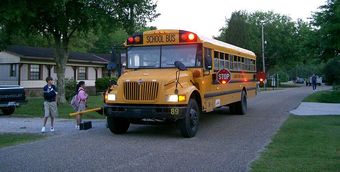
Desegregation and Busing
The Coleman Report led to busing programs to help integrate schools.
Relevance for Standardized Testing
The Coleman Report also fed the debate over the validity of standardized testing. The report showed that, in general, white students scored higher than black students, but it also showed significant overlap in scores: 15 percent of black students fell within the same range of academic accomplishment as the upper 50 percent of white students. This same group of blacks, however, scored higher than the other 50 percent of whites. Importantly, though, the report pointed out that the tests administered in these schools were not measuring intelligence, but rather an ability to learn and perform in the American environment. The report states: “These tests do not measure intelligence, nor attitudes, nor qualities of character. Furthermore they are not, nor are they intended, to be ‘culture free. ‘ Quite the reverse: they are culture bound. What they measure are the skills which are among the most important in our society for getting a good job and moving to a better one, and for full participation in an increasingly technical world. “
13.2.3: Tracking and Within-School Effects
Tracking separates students within a school into different tracks based on their skills and abilities.
Learning Objective
Argue for or against tracking in classrooms based on the information in the text
Key Points
- Proponents of tracking argue that it allows teachers to better direct lessons toward the specific ability level of the students in each class.
- Critics worry that by keeping students separate, tracking tends to reinforce class- and race-based disparities and worsen educational inequalities.
- Detracking occurs when students are deliberately positioned into classes of mixed ability. As opposed to tracking, students are no longer placed in groups based upon academic achievement or ability.
- While tracking separates students according to their skills and abilities, critics point out that it reinforces disparities and worsens educational inequalities.
Key Terms
- tracking
-
An educational system in which the entire school population is assigned to classes according to whether the students’ overall achievement is above average, normal, or below average and in which students attend academic classes only with students whose overall academic achievement is the same as their own.
- within school effects
-
Ways in which inequality may be produced or maintained among students in the same school.
Examples
- Supporters of tracking argue that it allows for higher achievement of high-ability students. A 1992 study by Kulik and Kulik found that high-ability students in tracked classes achieved more highly than similar-ability students in non-tracked classes.
- Some studies suggest that tracking can influence students’ peer groups and attitudes regarding other students. A 1992 study by Gamoran showed that students are more likely to form friendships with other students in the same tracks than students outside of their tracks.
Whereas the Coleman Report focused on between school effects, or inequality between different schools, other research has looked at within school effects, or ways in which inequality may be produced or maintained among students in the same school. One of the primary mechanisms for creating and maintaining inequality within schools is tracking. Tracking was once popular in English-speaking countries, but is less used now.
Advantages
Tracking consists of separating pupils into groups by academic ability. Student can be tracked for all subjects or for certain classes and curriculum within a school. Proponents of tracking argue that it allows teachers to better direct lessons toward the specific ability level of the students in each class. Another positive aspect of tracking is that since it separates students by ability, students’ work is only compared to that of similar-ability peers. Supporters of tracking also note that it allows for higher achievement of high-ability students. A 1992 study by Kulik and Kulik found that high-ability students in tracked classes achieved more highly than similar-ability students in non-tracked classes.
Disadvantages
Studies show that, while tracking for regular instruction makes no real difference in scholastic achievement for low and average ability students, it does produce substantial gains for gifted students in tracks specially designed for the gifted and talented. In other words, tracking can promote even higher achievement among high-achieving students, but it does little to improve the achievement of lower achieving students. Additionally, some studies suggest that tracking can influence students’ peer groups and attitudes regarding other students. A 1992 study by Gamoran showed that students are more likely to form friendships with other students in the same tracks than students outside of their tracks .

Students Using Laptops in Classroom
Critics argue that tracking can promote even higher achievement among high-achieving students, but it does little to improve the achievement of lower achieving students.
Critics worry that by keeping students separate, tracking tends to reinforce rather than overcome educational inequalities. This may be particularly true since low-track classes tend to have higher proportions of low-income and minority students, while upper-track classes are often dominated by students from high socioeconomically backgrounds. In this respect, tracking may not only reinforce academic inequalities, but also reinforce class- and race-based disparities in educational quality. Students from more privileged backgrounds gain access to higher quality instruction in upper-level tracks, while, even within the same school, poorer students are relegated to lower-level, less challenging tracks.
The 2010 HBO documentary, A Small Act, documented Kenyan students’ difficulty affording secondary schools. These elite schools were viewed as pathway to law school, medical school, and other forms of advanced education. Students who were kicked out of school for insufficient funds were essentially fated to lives of poverty. In Kenya, having only a primary school education prepared one for menial labor, while secondary school equated to future social mobility for poor Kenyan children.
Detracking
Detracking occurs when students are deliberately positioned into classes of mixed ability. As opposed to tracking, students are no longer placed in groups based upon academic achievement or ability. Tracking can be associated with giving students in low-track classes less resources, fewer experienced teachers, low expectations, and non-challenging curricula. Proponents for detracking believe that low-track students will greatly benefit in school achievement if they are mixed in with high-track students .

A Navy technician welding
Vocational tracks may teach skills such as welding or encourage students to join the armed forces
13.2.4: The Social Reproduction of Inequality
Conflict theorists argue that the democratic mission of education has failed because it has reproduced social and economic inequalities.
Learning Objective
Explain, using conflict theory, how inequality is socially reproduced
Key Points
- In democratic societies, education is meant to be a path to opportunity, and public education is meant to ensure society continues to strive for equality.
- Persistent evidence indicates that education’s democratic mission has failed; rather than overcoming inequality, the educational system appears to reinforce it.
- Inequality is continually socially reproduced because the whole education system serves the interests of the dominant classes.
- According to conflict theorists, the myth of individual success through education obscures an important social fact: the individual failures of many students are in fact explained by large-scale social forces.
- Conflict theorists maintain that schools are a means to convey to students what constitutes knowledge and appropriate behavior as determined by the state—those in power.
- According to conflict theorists, children from lower-class backgrounds face a much tougher time in school; they must learn the standard curriculum as well as the hidden curriculum of middle class values.
Key Terms
- Lower-Class Backgrounds
-
Upbringings that are lower on the socioeconomic hierarchy.
- social reproduction of inequality
-
The idea that inequality is continually socially reproduced because the whole education system is overlain with ideology provided by the dominant group.
Example
- Working class students may begin to understand that they are in a double-bind: either they must strive to succeed, and in doing so abandon their own culture in order to absorb the school’s middle class values, or they will fail to climb the social ladder.
In democratic societies, education is meant to be a path to opportunity, and public education is meant to ensure society continues to strive for equality. Students who work hard in school should be able to land good jobs and advance themselves, climbing the latter to social and economic success. Yet persistent evidence indicates that education’s democratic mission has failed; rather than overcoming inequality, the educational system appears to reinforce it. According to conflict theorists, this is a predictable result of capitalism and other forces of domination and inequality.
Social Reproduction of Inequality
Conflict theorists believe that educational institutions operate as mechanisms for the social reproduction of inequality. Inequality is continually socially reproduced because the whole education system is overlain with a dominant group’s ideology. The premise that education fosters equal opportunity is regarded as a myth, perpetuated to serve the interests of the dominant classes. According to this myth, those who fail to achieve success have only themselves to blame. According to conflict theorists, this myth obscures an important social fact—the individual failures of many students can be explained by large-scale social forces.
Conflict theorists argue that schools, like society in general, are based on exploitation, oppression, domination, and subordination. From teaching style to the formal curriculum, schools are a means to convey what constitutes knowledge and appropriate behavior as determined by the state—those in power. Thus, students must learn not only basic skills such as reading, writing, and math, but also skills useful in a capitalist economy and behaviors appropriate to the work environment, especially docility and obedience to a manager or boss—the teacher.
Class and Education
Some students may realize the perverse but unacknowledged goals of education, as they begin to see that much of what they learn seems, from their perspective, pointless. Anti-school values displayed by these children are often derived from their consciousness of their real interests. For example, working class students may begin to understand that they are in a double-bind: either they must strive to succeed, and in doing so abandon their own culture in order to absorb the school’s middle class values, or they will fail. Children from lower-class backgrounds face a much tougher time in school, where they must learn the standard curriculum as well as the hidden curriculum of middle class values. For those who aim to succeed and advance, they must confront the material inequalities created by unequal funding arrangements.
On the other hand, for middle and especially upper-class children, maintaining their superior position in society requires little effort. These students have the benefit of learning middle class values at home, meaning they come to school already having internalized the hidden curriculum. They also have access to higher quality instruction. In this way, the continuation of privilege and wealth for the elite is made possible.
13.2.5: Intelligence and Inequality
Educational capital can produce or reproduce inequality and also serve as a leveling mechanism that fosters equal opportunity.
Learning Objective
Devise two separate scenarios, one in which educational capital serves as a leveling mechanism and one in which academic capital reproduces inequality
Key Points
- The term educational capital is a concept that expands upon the theoretical ideas of French sociologist and anthropologist Pierre Bourdieu.
- Bourdieu’s perspective reveals how objective structures play an important role in determining individual achievement in school, but allows for the exercise of an individual’s own free will and abilities to overcome these barriers, although this choice is not without its penalties.
- Academic capital is a term used by sociologists to represent how an individual’s amount of education and other academic experience can be used to gain a more esteemed place in society.
Key Terms
- Educational Capital
-
The social standing one achieves by succeeding in academia and achieving academic credentials.
- Academic Capital
-
A term referring to how an individual’s amount of education and other academic experience can be used to gain a more esteemed place in society.
- sociability
-
The skill, tendency or property of being sociable or social, and interacting well with others.
Example
- In the most basic sense, academic capital is strongly tied to earning potential. Individuals with only a high school diploma, on average, make $20,000 less annually than individuals with an undergraduate degree, according to the U.S. Bureau of Labor Statistics. For individuals who do not have a high school degree, opportunities for monetary earning fall further, $30,000 less than those with a degree.
Although schools’ manifest function is to educate and train intelligence, they also have latent functions like socializing students. Students who do best in school are not always the most intelligent, but are usually culturally competent and sociable. The manifest function of education is to transmit knowledge to students. However, education also offers several latent functions, one of which is to foster social skills. Like the academic skills learned there, the social skills learned in school turn out to be quite important to a student’s future success in life . Students who score high on measures of sociability earn more money and get more education than equally intellectually gifted students who achieve lower scores in social skills.
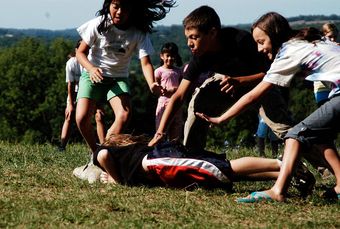
Children Playing
Inequality can arise from students’ different levels of social skills.
Manifest and Latent Functions
Manifest functions involve things people expect or can observe. In the above paragraph, it is the purpose of and people expect a school to teach or transmit knowledge. Latent functions are not generally recognized or intended; rather, they are a secondary effect of manifest functions. For example, it is not stated in the curriculum that children learn social skills at school, but as a result of being around and working with other children, socialization occurs. Socialization is slowly transforming into a manifest function, especially within special education and working with children on the autism spectrum, who suffer from serious social skill deficits. In these cases, social skills training is part of the curriculum for those particular children.
Educational Capital
The term educational capital is a concept that expands upon the theoretical ideas of French sociologist and anthropologist Pierre Bourdieu who applied the notion of capital to social capital, cultural capital, and symbolic capital. Pierre Bourdieu and Basil Bernstein explored how the cultural capital of the dominant classes has been viewed throughout history as the “most legitimate knowledge. ” How schools choose the content and organization of curriculum and instructional practices connects scholastic knowledge to dynamics of class, gender, and race both outside and inside our institutions of education. Educational capital refers to educational goods that are converted into commodities to be bought, sold, withheld, traded, consumed, and profited from in the educational system. Educational capital can be utilized to produce or reproduce inequality, and it can also serve as a leveling mechanism that fosters social justice and equal opportunity. Therefore Bourdieu’s perspective reveals how objective structures play an important role in determining individual achievement in school, but allows for the exercise of an individual’s own free will and abilities to overcome these barriers, although this choice is not without its penalties.
Academic Capital
Academic capital is a term used by sociologists to represent how an individual’s amount of education and other academic experience can be used to gain a place in society. On an individual level, academic capital influences and informs several important aspects of life. In the most basic sense, academic capital is strongly tied to earning potential. Individuals with only a high school diploma, on average, make $20,000 less annually than individuals with an undergraduate degree, according to the U.S. Bureau of Labor Statistics. For individuals who do not have a high school degree, opportunities for monetary earning fall further, $30,000 less than those with a degree.
13.3: Schools as Formal Organizations
13.3.1: Bureaucratization of Schools
The bureaucratization of schools has some advantages but has also led to the perpetuation of discrimination and an aversion to change.
Learning Objective
Discuss the critical issues and historial origins of school bureaucratization, particularly in relation to educational reform and deliverance of service
Key Points
- A bureaucracy is a large, formal, secondary organization characterized by a hierarchy of authority, a clear division of labor, explicit rules, and impersonal interactions between its members.
- In theory, bureaucracies are meritocracies that improve efficiency, ensure equal opportunities, and increase efficiency. In reality, some individuals benefit from structural privileges and social origins like a dominant race, language, or culture to which some other individuals may not have access.
- The foundations of the current educational system originated in the Industrial Revolution. The school environment became structured around hierarchy, standardization, and specialization.
- The bureaucratization of schools makes it difficult to instigate appropriate and immediate change when it is required by the changing needs of a society.
- In a pluralistic society, disseminating the dominant culture through public education is a topic of heated social debate. Religious, cultural, and ethnic groups can feel marginalized and alienated when they are forced to conform to bureaucratic structures.
- Advances in information technologies provide constant connectivity to the virtual world. Schools have begun to take advantage of these virtual tools as enhancements and replacements of physical school structures and face-to-face learning experiences.
Key Terms
- “one best system”
-
The idea that there is one uniform, standardized approach that forms the best strategy to educate all children.
- hierarchy
-
Any group of objects ranked so that everyone but the topmost is subordinate to a specified group above it.
- Education reform
-
The process of improving public education.
Examples
- Schools are environments structured around hierarchy, standardization, and specialization of certain skills. The structural rules and protocol of a bureaucratic school can marginalize groups that have not undergone cultural immersion or sufficient socialization into a society’s value system. These groups are more likely to experience institutional discrimination in the bureaucratized school system. Micro-level aggression can be subtler than outright discrimination like racial slurs. For example, understanding the English language is a valuable skill in American society. A child that grew up in a household where English is not the spoken language might have more problems comprehending English vocabulary in primary school than other students from English-speaking households. In the American classroom of a bureaucratized school, teachers might discriminate against this student by interacting with the student as if he/she were less capable than his/her peers of learning course material. Another example could be a child raised on cultural values of silence and obedience who enters a course dependent on argumentative and talkative students for classroom discussions. The teacher and the child’s peers might discriminate against the child in micro-level interactions based on assumptions that the child does not have anything intelligent to contribute or does not want to actively participate in classroom learning. Since the bureaucratic system of the school is modeled for the dominant group and its cultural values, these hypothetical examples might lead teachers to place students with different social origins than the dominant group in remedial courses or slower learning tracks.
- The adaption of technology is spreading among school districts for any variety of reasons including the ability to exploit Internet access or as a government-funded initiative. The data gathered from the Virtual Educational Organization case study describes how one school district was in the formative stage of developing a virtual organizational structure based upon a convergence of high quality software, Internet connectivity, and capacity building to support digital teaching and learning. This school district was actively adopting technology and software as integrated, and integral, components of the traditional bureaucratic hierarchical brick and mortar system of schooling. Not only was technology changing the nature of teaching and learning, aspects of the educational organization were being replaced by software that extended the nature of school organization into virtual management, virtual leadership, virtual pedagogy, and virtual learning that resulted in online and hybrid courses that, taken together, were an extension of the local school and school district. This study indicated that this K-12 educational organization was taking technology beyond a useful application of computers as one-dimensional tools to an emerging multi-dimensional media rich structure that extended learning into a personalized digital educational experience.
A bureaucracy is an organization of non-elected officials of a government or organization who implement the rules, laws, and functions of their institution. In modern society, all formal organizations are, or likely will become, bureaucracies.
According to Weber
The German sociologist and political economist Max Weber (1864-1920) began to study bureaucracy and popularize the term in academic literature and discourse during the mid 1800s and early 1900s. Weber believed that bureaucracy was the most efficient and rational way of organizing. For Weber, bureaucratization was the key process in his theory on rationalization of Western society. Weber popularly characterized a bureaucracy as having a hierarchy of authority, a clear division of labor, explicit rules, and impersonality.
Critical Issues of School Bureaucratization
There are several positive aspects of bureaucracies. They are intended to ensure equal opportunities and increase efficiency based on a meritocratic structure. Meritocracy means that hiring and promotion should be based on proven and documented skills, rather than on nepotism or random choice. For example, in order to get into a prestigious college, you need to perform well on the SAT and have an impressive transcript. In order to become a lawyer and represent clients, you must graduate from law school and pass the state bar exam. However, the theory of meritocracy becomes convoluted when it is applied to schools because some individuals have access to privileges that give them advantages over other individuals. For example, wealthy families can hire tutors, interview coaches, test-prep services, and consultants to help their kids gain the valued skills that will ultimately help them get into the best schools.
Despite good intentions and abundant rhetoric about “equal educational opportunity,” schools have rarely taught the children of the poor effectively. This failure has been systematic, not idiosyncratic. Talk about “keeping the schools out of politics” has often served to obscure actual alignments of power and patterns of privilege. For example, before the Emancipation Proclamation, many black people sought education through private, voluntary schools, which shows that they had a strong desire for education, generally believing that they could improve their social status through the equalizing power of schooling. However, they were excluded from the school system by segregation laws. Even after desegregation, black students faced intense racism in mixed schools, and minority students continue to face institutional racism and discrimination on the level of micro-interactions.
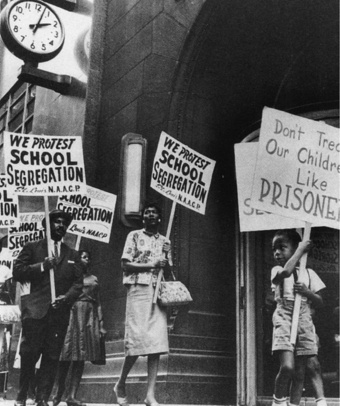
Protest Against the Racial Segregation of U.S. Schools
School bureaucracies struggle with the political challenge of defining a valuable educational curriculum and regulating the constituency that has access to those educational opportunities.
Historical Origins of School Bureaucratization
In order to understand the bureaucratization of schools, we must understand the historical development of the school system. When the U.S. transformed into an urban, industrial nation, corporations flourished, potential employees needed an education for a decent job, child labor laws were enforced, and the urban school system changed. During the Industrial Revolution, bureaucracies developed alongside the educational foundations for the current school model. Young workers were trained and organizations were built for mass production, assembly line work, and factory jobs. In schools, students learned to value hierarchical command, standardized outcomes, and specialized skills. These needs formed the basis for school bureaucracies today.
Various interest groups have continually called for education reform. However, bureaucratic authority often perpetuates positions and outworn practices of bureaucracy at the expense of timely change and appropriate education for children’s needs. City councils, school boards, superintendents, principals, and government officials from different interest groups and standpoints disagree about the “one best system” for the reproduction of American society. Most critics of school bureaucracies do not question the aim of transmitting the dominant culture through public education, but some dissenters oppose this strategy precisely because they fear children will lose valuable cultural differences through their socialization in the American system. Immigration trends have posed serious concerns for public school education systems because immigrants often bring religious, ethnic, and cultural differences to the classroom that differ from the protocol and ideology of “one best system. ” School bureaucracies seek to assimilate foreigners by teaching them English, indoctrinating them in American civics, and providing them with skills and habits needed in the urban job market.
Modern Society and School Bureaucratization
The assumption that there is “one best system” for educating children has been especially problematic within the context of a pluralistic American society, a globalized world, and advances in information technology. Now, in the information age, this kind of rigid training and adherence to protocol can actually decrease both productivity and efficiency. The model of American education based upon the industrial factory is undergoing a revolution based upon emerging technologies that redefine school organization as a virtual as well as a physical learning environment. In the twenty-first century teaching, learning, and the educational system itself have been buffeted by forces that challenged the traditional bureaucratic arrangement of schools with tall administrative hierarchies, centralized decision-making, and tightly controlled structures.

Ford Assembly Line 1913
The Industrial Revolution altered the purpose of the education system. Young workers were trained and organizations were built for mass production, assembly line work, and factory jobs. In schools, students learned to value hierarchical command, standardized outcomes, and specialized skills.
13.3.2: Teachers: Employees and Instructors
A teacher is a person who provides education for pupils and students.
Learning Objective
Discuss the purpose and roles of teachers in society, as well as the objectives of teaching
Key Points
- Teachers, like other professionals, may have to continue their education after they qualify, a process known as continuing professional development.
- In education, teachers facilitate student learning, often in a school or academy, but also in other environments such as outdoors. A teacher who teaches on an individual basis may be described as a tutor.
- The relationship between children and their teachers tends to be closer in the primary school, where they act as form tutor, specialist teacher, and surrogate parent during the course of the day.
Key Terms
- Professional Development
-
The means by which people maintain their knowledge and skills related to their professional lives.
- primary school
-
The first formal, obligatory school. Usually begins with kindergarten or first grade and ends at fifth or sixth grade.
- lesson plan
-
A teachers’ document used to plan a lesson.
Example
- In 2010, there were 3,823,142 teachers in public, charter, private, and Catholic elementary and secondary schools. They taught a total of 55,203,000 students, who attended one of 132,656 schools. In 2011, American teachers worked 1,097 hours in the classroom, the most for any industrialized nation measured by the Organization for Economic Cooperation and Development. They spend 1,913 hours a year on their work, just shy of the national average of 1,932 hours for all workers.
A teacher is a person who provides education for pupils and students. The role of teacher is often formal and ongoing, carried out at a school or other place of formal education. In many countries, a person who wishes to become a teacher must first obtain specified professional qualifications or credentials from a university or college. These professional qualifications may include the study of pedagogy, the science of teaching. Teachers, like other professionals, may have to continue their education after they qualify, a process known as continuing professional development. Teachers may use a lesson plan to facilitate student learning, providing a course of study that is called the curriculum.
Objectives
Teachers facilitate student learning, often but not always in a school or academy. A teacher who teaches on an individual basis may be described as a tutor. The objective is typically a course of study, lesson plan, or a practical skill. A teacher may follow standardized curricula as determined by the relevant authority. The teacher may interact with students of different ages (from infants to adults), students with different abilities, and students with learning disabilities.
Perhaps the most significant difference between primary school and secondary school teaching in the United States is the relationship between teachers and children. In primary schools, each class has a teacher who stays with them for most of the week and will teach them the whole curriculum. In secondary schools, they will be taught by different subject specialists each session during the week and may have ten or more different teachers. The relationship between children and their teachers tends to be closer in the primary school where they act as form tutor, specialist teacher, and surrogate parent during the course of the day.
Education in the United States
In 2010, there were 3,823,142 teachers in public, charter, private, and Catholic elementary and secondary schools. They taught a total of 55,203,000 students, who attended one of 132,656 schools. In 2011, American teachers worked 1,097 hours in the classroom, the most for any industrialized nation measured by the Organization for Economic Cooperation and Development. They spend 1,913 hours a year total on their work, just shy of the national average of 1,932 hours for all workers.
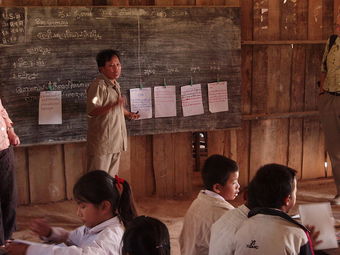
Teacher in Laos
Teacher in primary school in northern Laos.
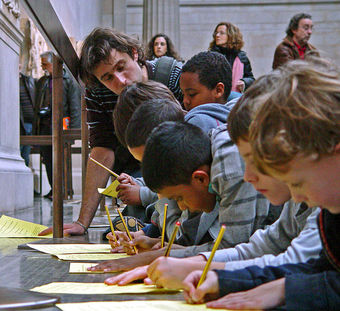
Teacher British Museum
A teacher and young pupils at the British Museum Duveen Gallery.
13.3.3: Student Subcultures
A youth subculture is a group characterized by distinct styles, behaviors and interests that offer an identity outside the mainstream.
Learning Objective
Discuss the definition and purpose of a subculture, especially for youth in society
Key Points
- The study of subcultures often consists of the study of symbolism attached to clothing, music or other visible affections by members of the subculture. It also studies the ways these same symbols are interpreted by members of the dominant culture.
- The term “scene” refers to an exclusive subculture or faction. It may also be geographically based, i.e. the London punk scene.
- Early studies in youth culture were mainly produced by functionalist sociologists and focus on youth as a single form of culture. In explaining the development of the culture, they utilized the concept of anomie.
- Marxists of the Frankfurt School of social studies argue that youth culture is inherently consumerist and integral to the divide-and-rule strategy of capitalism.
Key Terms
- Functional sociology
-
A framework for building theory that sees society as a complex system whose parts work together to promote solidarity and stability.
- Marxist theories
-
An economic and sociopolitical worldview and method of socioeconomic inquiry centered upon a materialist interpretation of history, a dialectical view of social change, and an analysis–critique of the development of capitalism.
- faction
-
A group of people, especially within a political organization, who express a shared belief or opinion different from people who are not part of the group.
Examples
- Youth music genres are associated with many youth subcultures; among them are punks, emos, ravers, Juggalos, metalheads and goths.
- Scenes can be used to describe geographic subsets of a subculture, such as the Detroit drum and bass scene or the London goth scene.
A youth subculture is group of young people defined by distinct styles, behaviors and interests. Youth subcultures offer participants an identity outside of that prescribed by social institutions like family, work, home and school. Youth subcultures that show a systematic hostility to the dominant culture are sometimes described as countercultures. Youth music genres are associated with many youth subcultures, and include punks, emos, ravers, Juggalos, metalheads and goths . The study of subcultures often consists of the study of the symbolism attached to clothing, music and other visible affections by members of the subculture. It also studies the ways these same symbols are interpreted by members of the dominant culture.

Emo Subculture
Example of a participant in emo subculture.
The term “scene” can refer to an exclusive subculture or faction. Scenes are distinguished from the broad culture through either fashion, identification with specific (sometimes obscure or experimental) musical genres or political perspectives, and a strong in-group or tribal mentality. The term can be used to describe geographic subsets of a subculture, like the Detroit drum and bass scene or the London goth scene.
Theories about Subcultures
Early studies in youth culture were mainly produced by those interested in functional sociology and focus on youth as a single form of culture. In explaining the development of the culture, they utilized the concept of anomie – a lack of social norms. Talcott Parsons argued that as we move from the family and corresponding values to another sphere with differing values, we would experience an “anomie situation. “
Marxist theories account for some diversity, as they focus on classes and class-fractions rather than youth as a whole. Stuart Hall and Tony Jefferson described youth subcultures as symbolic or ritualistic attempts to resist the power of bourgeois hegemony by consciously adopting behavior that appears threatening to the establishment. Conversely, Marxists of the Frankfurt School of social studies argue that youth culture is inherently consumerist and integral to the divide-and-rule strategy of capitalism.
Subcultures may also be seen as extensions of crowds. Certain crowds are found in many, even most, high schools across the United States, although the particular terms used by adolescents in them vary (nerds instead of geeks, goths instead of emos, etc.). Most of these can be found in other western countries as well, with the exception of jocks.

Ravers
Ravers adorned in reflective Phat Pants.
13.3.4: Homeschooling
Homeschooling is the education of children at home, rather than in other formal settings of public or private school.
Learning Objective
Examine the various reasons people homeschool children, as well as the pros and cons of choosing to homeschool
Key Points
- Homeschooling is a legal option for parents in many countries, allowing them to provide their children with a learning environment as an alternative to public or private schools.
- There are a few common reasons parents homeschool their children. Parents might be concerned about the traditional school social environment, they might want to provide a religious or moral education, or they might simply be dissatisfied with the academic quality of schools.
- A homeschool cooperative is a cooperative of families who homeschool their children.
- Unschooling is a range of educational philosophies and practices centered on allowing children to learn through their natural life experiences, including play, gameplay, household responsibilities, work experience, and social interaction. This is a very controversial method.
Key Terms
- homeschooling
-
teaching children at home instead of sending them to school
- unschooling
-
a range of educational philosophies and practices centered on allowing children to learn through their natural life experiences, including play, games, household responsibilities, work experience, and social interaction, rather than through a more traditional school curriculum
- e-learning
-
learning conducted via electronic media, especially via the Internet
Examples
- Numerous studies have found that homeschooled students, on average, outperform their peers on standardized tests. “Homeschooling Achievement,” a study conducted by National Home Education Research Institute (NHERI), a homeschooling advocacy group, supported the academic integrity of homeschooling. Among students who took specific tests, the average homeschooled student outperformed his public school peers by 30 to 37 percentile points in every subject. The study also indicates that public school performance gaps, such as those between minorities and genders, were virtually non-existent among the homeschooled students.
- In the 1970s, Raymond S. and Dorothy N. Moore conducted four federally funded analyses of more than 8,000 early childhood studies, from which they published their original findings in Better Late Than Early, 1975. They concluded that, “where possible, children should be withheld from formal schooling until at least ages eight to ten. “
Homeschooling
Homeschooling is the education of children at home, rather than in the formal settings of public or private school. Typically, homeschool instruction is delivered by parents, but sometimes tutors are hired for this job. Historically, before the advent of compulsory school attendance laws, most childhood education occurred at home or in the community. Today however, homeschooling is very much an alternative to attending public or private schools. Homeschooling is a legal option for parents in many countries. It allows them to provide their children with a learning environment if they are dissatisfied with offerings at public or private schools.
Motivations
Parents can have a number of motivations for wanting to homeschool their children. Among these, three of the most common are the following. Parents might be concerned about the traditional school environment, they might want to provide a particular type of religious or moral instruction, or they might simply be dissatisfied with the academic quality of traditional public or private schools.
Homeschooling may also reflect an individual’s parenting style. It can be used as a form of supplementary education, geared towards helping children succeed in specific circumstances. For example, children that attend poorly funded schools might benefit greatly from certain homeschool methods, like using the internet. In conjunction with this e-learning, homeschooling could theoretically be combined with a traditional school curriculum to produce more well-rounded results.
Homeschooling Communities
A homeschool cooperative is a cooperative of families who homeschool their children. These co-ops provide homeschooled children the opportunity to learn from other parents who might be more specialized in certain areas or subjects. Co-ops also provide critical opportunities for social interaction among homeschooled children. In these co-ops, children might take lessons or go on field trips together. Some co-ops also offer events like prom and graduation, to simulate certain seminal moments of a traditional educational experience. Through the use of the Internet, homeschoolers are beginning to simulate these cooperative activities online. Using social networking software, homeschoolers can chat, discuss threads in forums, share information, and even participate in online classes via blackboard systems similar to those used by colleges.
Unschooling
Unschooling refers to a range of educational philosophies and practices centered on allowing children to learn through their natural life experiences. These methods can include play, games, household responsibilities, work experience, and social interaction, and form a distinct alternative to a more traditional school curriculum. There are many who find this method of education controversial and potentially unethical. In unschooling, children are encouraged to utilize their own initiative to explore activities, with parental facilitation. The unschooling philosophy of education differs from conventional schooling because it believes that standard curricula and conventional grading methods are counterproductive to the educational growth of a child.
Comparative Studies
Numerous studies have found that homeschooled students, on average, outperform their peers on standardized tests. “Homeschooling Achievement,” a study conducted by National Home Education Research Institute (NHERI), an advocacy group, revealed the academic integrity of homeschooling. Among students who took the tests, the average homeschooled student outperformed his public school peers by 30 to 37 percentile points in every subject. Importantly, the study also indicated that public school performance gaps, such as those between races and genders, were virtually non-existent among homeschooled students.
In the 1970s, Raymond S. Moore and Dorothy N. Moore conducted four federally funded analyses of more than 8,000 early childhood studies. They eventually published their findings in 1975, and concluded that, “where possible, children should be withheld from formal schooling until at least ages eight to ten. “

Homeschooler with Project
Homeschooler challenging The Leaning Tower of Pasta project, to build a tower using only pasta and marshmallows and measure its height and strength.
13.4: The Functionalist Perspective on Education
13.4.1: Socialization
According to functionalists, the socialization process is coercive, forcing us to accept to the values and norms of society.
Learning Objective
Examine socialization in three ways – the functionalist perspective, and according to Merton and Parsons
Key Points
- Structural functionalists view the socialization process as one where the values and norms of society are agreed upon by all members of society because there is a “social contract” in effect which protects us from one another and keeps society stable and balanced.
- Socialization refers to the lifelong process of inheriting and disseminating norms, customs and ideologies, providing an individual with the skills and habits necessary for participating within his or her own society.
- The values and norms of society are agreed upon by all members of society because there is a “social contract” in effect which protects us from one another and keeps society stable and balanced.
- Robert K. Merton coined the term “role model” and hypothesized that individuals compare themselves with reference groups of people who occupy the social role to which the individual aspires.
- The key processes for Talcott Parsons for system reproduction are socialization and social control.
- Socialization is supported by the positive and negative sanctioning of role behaviors that do or do not meet these expectations.
Key Terms
- social contract
-
An implicit agreement or contract among members of a society that dictates things that are considered acceptable conduct.
- Reference Groups
-
Groups to which a person may compare himself to.
Example
- One might use a reference group to determine his or her affluence: An individual in the U.S. with an annual income of $80,000, may consider himself affluent if he compares himself to those who earn roughly $35,000 a year. If, however, the same person considers the relevant reference group to be those in the top 0.1% of households in the U.S., those making $1.6 million or more, then the individual’s income of $80,000 would make him or her seem rather poor.
Socialization is a term that refers to the lifelong process of inheriting and disseminating norms, customs and ideologies, providing an individual with the skills and habits necessary for participating within his or her own society . Socialization describes a process that may lead to desirable or moral outcomes. Individual views on certain issues, such as race or economics, may be socialized within a society.

Toddler Socialization
Three-year-old female toddler showing signs of healthy socialization: Having lifted her shirt, she is concentrating on playing at attaching an under-nourished doll to her breast. Her sister is four months old and breast fed on demand.
Functionalist Perspective on Socialization
The Functionalist paradigm describes society as stable and describes all of the various mechanisms that maintain social stability. Functionalism argues that the social structure is responsible for all stability and instability, and that that the social structure is continuously attempting to maintain social equilibrium among all the components of society.
According to functionalists, the socialization process is coercive, forcing us to accept the values and norms of society. The values and norms of society are agreed upon by all members of society because there is a “social contract” in effect which protects us from one another and keeps society stable and balanced. People follow and accept the values and norms of society in order to maintain their own safety as well as maintaining social order.
Robert K. Merton
The term role model generally means any “person who serves as an example, whose behavior is emulated by others. ” The term first appeared in Robert K. Merton’s socialization research of medical students. Merton hypothesized that socialization happens when individuals compare themselves with reference groups of people who occupy the social role to which the individual aspires. Beginning with Merton, sociologists call any group that individuals use as a standard for evaluating themselves and their own behavior a reference group. For example, an individual in the U.S. with an annual income of $80,000, may consider himself affluent if he compares himself to those who earn roughly $35,000 a year. If, however, the same person considers the relevant reference group to be those in the top 0.1 percent of households in the U.S., those making $1.6 million or more, then the individual’s income of $80,000 would make him or her seem rather poor.
Talcott Parsons
Talcott Parsons was heavily influenced by Emile Durkheim and Max Weber, synthesizing much of their work into his action theory, which he based on the system-theoretical concept and the methodological principle of voluntary action. The key processes for Parsons for system reproduction are socialization and social control. Socialization is important because it is the mechanism for transferring the accepted norms and values of society to the individuals within the system. Parsons never spoke about “perfect socialization”—in any society socialization was only partial and “incomplete” from an integral point of view. Socialization is supported by the positive and negative sanctioning of role behaviors that do or do not meet these expectations. A punishment could be informal, like a snicker or gossip, or more formalized, through institutions such as prisons and mental institutions.

Socialization of Direct Marketing
The concept of socialization being used for advertising.
13.4.2: Cultural Transmission
Cultural transmission is the way a group of people within a society or culture tend to learn and pass on new information.
Learning Objective
Analyze the importance of cultural transmission, particularly in terms of learning styles
Key Points
- Learning styles are greatly influenced by how a culture socializes with its children and young people.
- The process by which a child acquires his or her own culture is referred to as enculturation.
- On the basis of cultural learning, people create, remember, and deal with ideas. They understand and apply specific systems of symbolic meaning.
- A meme is “an idea, behavior or style that spreads from person to person within a culture. ” The term was coined by the British evolutionary biologist Richard Dawkins in The Selfish Gene (1976).
- Intercultural competence is the ability to communicate successfully with people of other cultures.
Key Terms
- Intercultural Competence
-
The ability to communicate successfully with people of other cultures.
- Cultural Transmission
-
The way a group of people or animals within a society or culture tend to learn and pass on new information.
- Symbolic Meaning
-
Meaning that is conveyed through language; when one knows that X means Y.
Example
- While interacting with people from other cultures, an individual generally faces certain obstacles, which are caused by differences in cultural understanding between the two people in question. For example, showing the thumb held upwards in certain parts of the world means “everything’s okay,” while it is understood in some Islamic countries as a rude sexual sign.
Cultural transmission is the way a group of people or animals within a society or culture tend to learn and pass on new information. Learning styles are greatly influenced by how a culture socializes with its children and young people. The key aspect of culture is that it is not passed on biologically from the parents to the offspring, but rather learned through experience and participation. The process by which a child acquires his or her own culture is referred to as “enculturation. ” Cultural learning allows individuals to acquire skills that they would be unable to independently over the course of their lifetimes.
Cultural Transmission for Humans
Cultural learning is believed to be particularly important for humans. Humans are weaned at an early age compared to the emergence of adult dentition. The immaturity of dentition and the digestive system, the time required for growth of the brain, the rapid skeletory growth needed for the young to reach adult height and strength means that children have special digestive needs and are dependent on adults for a long period of time. This time of dependence also allows time for cultural learning to occur before passage into adulthood.
On the basis of cultural learning, people create, remember, and deal with ideas. They understand and apply specific systems of symbolic meaning. Cultures have been compared to sets of control mechanisms, plans, recipes, rules, or instructions. Cultural differences have been found in academic motivation, achievement, learning style, conformity, and compliance. Cultural learning is dependent on innovation or the ability to create new responses to the environment and the ability to communicate or imitate the behavior of others. A meme is “an idea, behavior or style that spreads from person to person within a culture. ” A meme acts as a unit for carrying cultural ideas, symbols or practices, which can be transmitted from one mind to another through writing, speech, gestures, rituals, or other imitable phenomena. The term was coined by the British evolutionary biologist Richard Dawkins in The Selfish Gene (1976).
Intercultural Competence
Intercultural competence is the ability to communicate successfully with people of other cultures. In interactions with people from foreign cultures, a person who is interculturally competent understands culture-specific concepts in perception, thinking, feeling, and acting. The interculturally competent person considers earlier experiences free from prejudices, and has an interest in, and motivation towards, continued learning.
The development of intercultural competence is mostly based on the individual’s experiences while communicating with different cultures. While interacting with people from other cultures, the individual generally faces certain obstacles, which are caused by differences in cultural understanding between the two people in question. Such experiences motivate the individual to work on skills that can help him communicate his point of view to an audience belonging to a completely different cultural ethnicity and background. For example, showing the thumb held upwards in certain parts of the world means “everything’s okay,” while it is understood in some Islamic countries as a rude sexual sign. Additionally, the thumb is held up to signify “one” in France and certain other European countries, where the index finger is used to signify “one” in other cultures. In India and Indonesia, it is often regarded as wishing “all the best.”
13.4.3: Academic Skills and Knowledge
In academia, an individual’s educational level and other academic experience can be used to gain a place in society.
Learning Objective
Examine the implications of academia in society, especially in terms of structure, qualifications and academic capital
Key Points
- Academia is the community of students and scholars engaged in higher education and research.
- Academia is usually conceived of as divided into disciplines or fields of study.
- The degree awarded for completed study is the primary academic qualification. Typically these are, in order of accomplishment, associate’s degree, bachelor’s degree, master’s degree, and doctorate.
- In the United States, “professors” commonly occupy any of several positions in academia, typically the ranks of assistant professor, associate professor, or full professor.
- Academic capital is a term used by sociologists to represent how an individual’s amount of education and other academic experience can be used to gain a place in society.
Key Terms
- Academic Capital
-
A term referring to how an individual’s amount of education and other academic experience can be used to gain a more esteemed place in society.
- academia
-
The scientific and cultural community engaged in higher education and research, taken as a whole.
Examples
- As of August 2007 teaching in tertiary educational institutions is one of the fastest growing occupations, topping the U.S. Department of Labor’s list of “above average wages and high projected growth occupations,” with a projected increase of 524,000 positions between 2004 and 2014.
- Bourdieu’s definition of academic capital is applicable to any individual: even an individual interviewing for a secretarial position would benefit from having more schooling than another candidate
Academia is the community of students and scholars engaged in higher education and research. In Western Europe, universities were founded in the twelfth and thirteenth centuries, and the European institution of Academia took shape. Monks and priests moved out of monasteries to cathedral cities and other towns where they opened the first schools dedicated to advanced study. In the United States, the term “academic” is approximately synonymous with that of the job title professor, although in recent decades a growing number of institutions include librarians in the category of “academic staff. “
Structure
Academia is usually conceived of as divided into disciplines or fields of study. The disciplines have been much revised, and many new disciplines have become more specialized, researching smaller and smaller areas. Because of this, interdisciplinary research is often prized in today’s academy, though it can also be made difficult both by practical matters of administration and funding and by differing research methods of different disciplines. In fact, many new fields of study have initially been conceived as interdisciplinary, and later become specialized disciplines in their own right. On recent example is cognitive science.
Qualifications
The degree awarded for completed study is the primary academic qualification. Typically, these are, in order of completion, associate’s degree, bachelor’s degree, master’s degree, and doctorate. In the United States, “professors” commonly occupy any of several positions in academia, typically the ranks of assistant professor, associate professor, or full professor. Research and education are among the main tasks of professors with the time spent in research or teaching depending strongly on the type of institution. Publication of articles in conferences, journals, and books is essential to occupational advancement. As of August 2007, teaching in tertiary educational institutions is one of the fastest growing occupations, topping the U.S. Department of Labor’s list of “above average wages and high projected growth occupations,” with a projected increase of 524,000 positions between 2004 and 2014.
Academic Capital
“Academic capital” is a term used by sociologists to represent how an individual’s amount of education and other academic experience can be used to gain a place in society. The term originated in 1979 when Pierre Bourdieu (1930–2002), a prominent French sociologist, used the term in his book, Distinction: A Social Critique of the Judgment of Taste. The book attempts to show how individuals are not defined by social class, but instead by their “social space,” which is dependent on each type of capital the individual has.
Much like other forms of capital, social capital, economic capital, and cultural capital, academic capital doesn’t depend on one sole factor but instead is made up of many different factors, including the individual’s academic transmission from his/her family, status of the academic institutions attended, and publications produced by the individual. Since Bourdieu first coined the term, it has been used widely to discuss many of the implications involved with schooling and the rise of individuals in academia. Numerous studies have been done involving the idea of academic capital, and scholars have disagreed on what counts as academic capital.
Bourdieu’s definition of the term is applicable to any individual. However, it seems that most references to academic capital point solely to professional teachers and researchers within higher education. For example, in 2009, Michael Burawoy defined academic capital as being estimated from an individual’s curriculum vitae, but admitted that it was subjective because some fields of study seem to value certain academic qualities more than others—research.

Oxford University
Academia is the community of students and scholars engaged in higher education and research
13.4.4: Innovation
Innovation is the creation of better or more effective products, processes, services, technologies, or ideas.
Learning Objective
Compare the difference between innovation and invention, as well as the pros and cons of each
Key Points
- Innovation differs from invention in that innovation refers to the use of better and, as a result, novel idea or method, whereas invention refers more directly to the creation of the idea or method itself.
- Innovation differs from improvement in that innovation refers to the notion of doing something different rather than doing the same thing better.
- In society, innovation aids in comfort, convenience, and efficiency in everyday life.
- In the organizational context, innovation may be linked to positive changes in efficiency, productivity, quality, competitiveness, market share, and others.
- When an innovative idea requires a better business model, or radically redesigns the delivery of value to focus on the customer, a real-world experimentation approach increases the chances of market success.
- Once innovation occurs, innovations may be spread from the innovator to other individuals and groups. This process can be described using the “s-curve” or diffusion curve. This is known as the process of diffusion.
Key Terms
- business model
-
The particular way in which a business organization ensures that it generates income, one that includes the choice of offerings, strategies, infrastructure, organizational structures, trading practices, and operational processes and policies.
- organization
-
A group of people or other legal entities with an explicit purpose and written rules.
- improvement
-
Increase; growth; progress; advance.
Example
- All organizations can innovate, including hospitals, universities, and local governments. For instance, former Mayor Martin O’Malley pushed the City of Baltimore to use CitiStat, a performance-measurement data and management system that allows city officials to maintain statistics on everything from crime trends to condition of potholes. This system aids in better evaluation of policies and procedures with accountability and efficiency in terms of time and money. In its first year, CitiStat saved the city $13.2 million.
Innovation is the creation of better or more effective products, processes, services, technologies, or ideas that are readily available to markets, governments, and society. Innovation differs from invention in that innovation refers to the use of better and, as a result, a novel idea or method, whereas invention refers more directly to the creation of the idea or method itself. Innovation differs from improvement in that innovation refers to the notion of doing something different rather than doing the same thing better.
Due to its widespread effect, innovation is an important topic in the study of economics, business, entrepreneurship, design, technology, sociology, and engineering. In society, innovation aids in comfort, convenience, and efficiency in everyday life. For instance, the benchmarks in railroad equipment and infrastructure added to greater safety, maintenance, speed, and weight capacity for passenger services. These innovations included wood to steel cars, iron to steel rails, stove-heated to steam-heated cars, gas lighting to electric lighting, diesel-powered to electric-diesel locomotives. By mid-twentieth century, trains were making longer, more comfortable, and faster trips at lower costs for passengers
Organization
In the organizational context, innovation may be linked to positive changes in efficiency, productivity, quality, competitiveness, market share, and others. All organizations can innovate, including hospitals, universities, and local governments. For instance, former Mayor Martin O’Malley pushed the City of Baltimore to use CitiStat, a performance-measurement data and management system that allows city officials to maintain statistics on crime trends to condition of potholes. This system aids in better evaluation of policies and procedures with accountability and efficiency in terms of time and money. In its first year, CitiStat saved the city $13.2 million.
There are several sources of innovation. According to the Peter F. Drucker the general sources of innovations are different changes in industry structure, in market structure, in local and global demographics, in human perception, mood and meaning, in the amount of already available scientific knowledge, etc. When an innovative idea requires a better business model, or radically redesigns the delivery of value to focus on the customer, a real-world experimentation approach increases the chances of market success. Potentially, innovative business models and customer experiences can’t be tested through traditional market research methods. Programs of organizational innovation are typically tightly linked to organizational goals and objectives, the business plan, and to market competitive positioning. One driver for innovation programs in corporations is to achieve growth objectives. Once innovation occurs, innovations may be spread from the innovator to other individuals and groups. This process can be described as using the “s-curve” or diffusion curve. This is known as the process of diffusion.
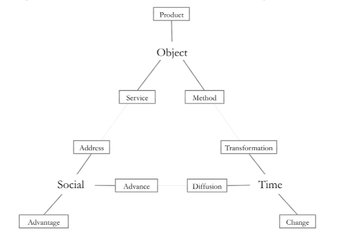
Innovation Diagram
Innovation 3D – The Innovation Triangle
13.4.5: Child Care
Child care involves caring for and supervising a child or children, usually from infancy to age thirteen.
Learning Objective
Analyze the different types of child care in the United States, from parental care to center-based care
Key Points
- It is traditional in Western society for children to be taken care of by their parents or their legal guardians.
- If a parent or extended family is unable to care for the children, orphanages and foster homes are a way of providing for children’s care, housing, and schooling.
- The two main types of child care options are center-based care and home-based care.
- Home-based care typically is provided by nannies, au-pairs, or friends and family.
- In 1995, over thirty-six percent of families of preschoolers with working mothers primarily relied on child care in the home of a relative, family day care provider or other non relative. Almost twenty-six percent of families used organized child care facilities as their primary arrangement.
Key Terms
- Home-based care
-
Child care that occurs in the child’s home as opposed to in a preschool or external institution.
- Center-based care
-
Child care that occurs outside of the child’s home, such as in a preschool.
- extended family
-
A family consisting of parents and children, along with either grandparents, grandchildren, aunts or uncles, cousins etc.
Example
- According to the 1995 U.S. Census Bureau Survey of Income and Program Participation (SIPP), over thirty-six percent of families of preschoolers with working mothers primarily relied on child care in the home of a relative, family day care provider or other non-relative. Almost twenty-six percent of families used organized child care facilities as their primary arrangement.
Child care involves supervising a child or children, usually from infancy to age thirteen, and typically refers to work done by somebody outside the child’s immediate family. Child care is a broad topic covering a wide spectrum of contexts, activities, social and cultural conventions, and institutions. The majority of child care institutions that are available require that child care providers have extensive training in first aid and are CPR certified. In addition, background checks, drug testing, and reference verification are normally required.
It is traditional in Western society for children to be cared for by their parents or their legal guardians. In families where children live with one or both of their parents, the child care role may also be taken on by the child’s extended family. If a parent or extended family is unable to care for the children, orphanages and foster homes are a way of providing for children’s care, housing, and schooling.
Types of Child Care
The two main types of child care options are center-based care and home-based care. In addition to these licensed options, parents may also choose to find their own caregiver or arrange child care exchanges/swaps with another family. In-home care typically is provided by nannies, au-pairs, or friends and family. The child is watched inside their own home or the caregiver’s home, reducing exposure to outside children and illnesses. Depending on the number of children in the home, the children utilizing in-home care enjoy the greatest amount of interaction with their caregiver, forming a close bond. There are no required licensing or background checks for in-home care, making parental vigilance essential in choosing an appropriate caregiver. Nanny and au-pair services provide certified caregivers and the cost of in-home care is the highest of child care options per child, though a household with many children may find this the most convenient and affordable option.
Child Care in the United States
State legislation may regulate the number and ages of children allowed before the home is considered an official daycare program and subject to more stringent safety regulations. Often the nationally recognized Child Development Associate credential is the minimum standard for the individual leading this home care program. Each state has different regulations for teacher requirements. In some states, teaching in a day care center requires an Associates Degree in child development. States with quality standards built into their licensing programs may have higher requirements for support staff, such as teacher assistants. And for Head Start Teachers, by 2012 all lead teachers must have a bachelors degree in Early Childhood Education. States vary in other standards set for daycare providers, such as teacher to child ratios.
According to the 1995 U.S. Census Bureau Survey of Income and Program Participation (SIPP), over thirty-six percent of families of preschoolers with working mothers primarily relied on child care in the home of a relative, family day care provider, or other non relative. Almost twenty-six percent of families used organized child care facilities as their primary arrangement .
13.4.6: Postponing Job Hunting
Job hunting is the act of looking for employment, due to unemployment or discontent with a current position.
Learning Objective
Examine the reasons why a person would job hunt and the common methods used
Key Points
- The immediate goal of job seeking is usually to obtain a job interview with an employer which may lead to getting hired.
- Common methods of job hunting are finding a job through a friend or an extended business network, personal network, online social network service, or employment website.
- Many job seekers research the employers to which they are applying. Some employers see evidence of this as a positive sign of enthusiasm for the position or the company.
Key Terms
- social networking
-
The use of Internet communities to network and communicate using shared interests, related skills, or geographical location between consumers and businesses.
- outplacement
-
The process of helping to find new employment for redundant workers, especially executives.
Examples
- Contacting as many people as possible is a highly effective way to find a job. It is estimated that 50% or higher of all jobs are found through networking.
- Contacting as many people as possible is a highly effective way to find a job. It is estimated that 50% or higher of all jobs are found through networking.
Job hunting is the act of looking for employment, due to unemployment or discontent with a current position. The immediate goal of job seeking is usually to obtain a job interview with an employer which may lead to getting hired. The job hunter typically first looks for job vacancies or employment opportunities. As of 2010, less than 10% of U.S. jobs are filled through online ads.
Common methods of job hunting are finding a job through a friend or an extended business network, personal network, or online social network service; using an employment website; looking through the classifieds in newspapers; using a private or public employment agency or recruiter; looking on a company’s web site for open jobs, typically in its applicant tracking system; going to a job fairs; using professional guidance such as outplacement services that give training in writing a résumé, applying for jobs, and how to be successful at an interview .

Jobseekers in Ethiopia
Job seekers in central Addis Ababa, Ethiopia review advertised opportunities.
Many job seekers research the employers to which they are applying, and some employers see evidence of this as a positive sign of enthusiasm for the position or the company, or as a mark of thoroughness. Information collected might include open positions, full name, locations, web site, business description, year established, revenues, number of employees, stock price if public, name of the chief executive officer, major products or services, major competitors, and strengths and weaknesses.
Contacting as many people as possible is a highly effective way to find a job. It is estimated that 50% or higher of all jobs are found through networking. Job recruiters and decision makers are increasingly using online social networking sites to gather information about job applicants, according to a mid-2011 Jobvite survey of 800 employers in the U.S. Job seekers need to begin to pay more attention to what employers and recruiters find when they do their pre-interview information gathering about applicants, according to this 2010 study by Microsoft, “Online Reputation in a Connected World.”
13.4.7: Gatekeeping
Gatekeeping is the process through which information in publications, broadcasting, and the Internet is filtered for dissemination.
Learning Objective
Discuss the concept and implications of the gatekeeping process and censorship
Key Points
- Originally focused on the mass media with its few-to-masses dynamic, theories of gatekeeping also now include the workings of face-to-face communication and the many-to-many dynamic now easily available via the Internet.
- Gatekeeping was formally identified in Kurt Lewin’s publication, Forces Behind Food Habits and Methods of Change (1943).
- Censorship is the suppression of speech or other public communication that may be considered objectionable, harmful, sensitive, or inconvenient as determined by a government, media outlet, or other controlling body.
Key Terms
- censorship
-
The use of state or group power to control freedom of expression, such as passing laws to prevent media from being published or propagated.
- Gatekeeping
-
Gatekeeping is practiced by gatekeepers, people who control access to something, for example, via a city gate. In the late twentieth century, the term came into metaphorical use, referring to individuals who decide whether a given message will be distributed by a mass medium.
- information
-
Things that are or can be known about a given topic; communicable knowledge of something.
Example
- Outside of media organizations, individuals can also act as gatekeepers, deciding what information to include in an email or in a blog, for example.
Gatekeeping is the process through which information is filtered for dissemination, be it publication, broadcasting, the Internet, or some other type of communication. As an academic theory, it is found in several fields, including communication studies, journalism, political science, and sociology. Originally focused on the mass media with its few-to-masses dynamic, theories of gatekeeping also now include the workings of face-to-face communication and the many-to-many dynamic now easily available via the Internet.
The Gatekeeping Process
According to Pamela Shoemaker and Tim Vos, gatekeeping is the “process of culling and crafting countless bits of information into the limited number of messages that reach people everyday. ” Gatekeeping as a news process was identified in the literature as early as 1922, though not yet given a formal theoretical name. Gatekeeping was formally identified in Kurt Lewin’s publication, Forces Behind Food Habits and Methods of Change (1943).

Kurt Lewin
Lewin was an influential behavioral and organizational psychologist who proposed the Phases of Change Model.
Lewin identified several parts of the gatekeeping process in his 1943 article. These parts include:
1. Information moves step by step through channels. The number of channels varies and the amount of time in each channel can vary.
2. Information must pass a “gate” to move from one channel to the next.
3. Forces govern channels. There may be opposing psychological forces causing conflict that creates resistance to movement through the channel.
4. There may be several channels that lead to the same end result.
5. Different actors may control the channels and act as gatekeepers at different times.
Censorship
Censorship is the suppression of speech or other public communication that may be considered objectionable, harmful, sensitive, or inconvenient as determined by a government, media outlet, or other controlling body. It can be done by governments and private organizations or by individuals who engage in self-censorship. It occurs in a variety of different contexts including speech, books, music, films and other arts, the press, radio, television, and the Internet. Censorship occurs for a variety of reasons including national security; to control obscenity, child pornography, and hate speech; to protect children; to promote or restrict political or religious views; to prevent slander and libel; and to protect intellectual property.
13.4.8: Replacing Family Functions
Family types that are replacing the traditional nuclear family include single parent families, cohabitation, and gay and lesbian families.
Learning Objective
Examine the different types of families and the changing face of family roles
Key Points
- Single parent families usually refers to a parent who has most of the day to day responsibilities in the raising of the child or children who is not living with a spouse or partner, or those who are not married.
- Cohabitation is an arrangement where two people who are not married live together in an intimate relationship, particularly an emotionally and/or sexually intimate one, on a long-term or permanent basis.
- Gay and lesbian couples are categorized as same sex relationships. In 1989 Demark was the first nation allow same sex couples to get married to provide equal rights to all citizens.
- Singlehood is a family that contains a person who is not married or in a common law relationship.
Key Terms
- Single Parent Families
-
Families in which the children are primarily raised by one parent rather than by both parents.
- cohabitation
-
An emotionally and physically intimate relationship that includes a common living place and which exists without legal or religious sanction.
- singlehood
-
The state of being single (unattached or unmarried).
Examples
- The number of married couples raising children has decreased over the years. In Canada, married and common law couples with children under the age of 25 represented 44% of all families in 2001.
- Gay and lesbian couples are categorized as same sex relationships. In 1989 Demark was the first nation allow same sex couples to get married to provide equal rights to all citizens.
The sociology of the family examines the family as an institution and a unit of socialization. Sociological studies of the family look at demographic characteristic of the family members: family size, age, ethnicity and gender of its members, social class of the family, the economic level and mobility of the family, professions of its members, and the education levels of the family members.
Current Studies
Currently, one of the biggest issues that sociologists study are the changing roles of family members. Often, each member is restricted by the gender roles of the traditional family. These roles, such as the father as the breadwinner and the mother as the homemaker, are declining. Now, the mother is often the supplementary provider while retaining the responsibilities of child rearing. In this scenario, females’ role in the labor force is “compatible with the demands of the traditional family. ” Sociology studies the adaptation of males’ role to caregiver as well as provider. The gender roles are increasingly interwoven.
Alternate Family Forms
The number of married couples raising children has decreased over the years. In Canada, married and common law couples with children under the age of 25 represented 44% of all families in 2001. This statistic has lowered since 1991, when married and common law couples raising children under the age of 25 represented 49% of all Canadian families. There are various other family forms that are becoming increasingly common.
A single parent family usually refers to a parent who has most of the day-to-day responsibilities in the raising of the child or children, who is not living with a spouse or partner, or who is not married. The dominant caregiver is the parent with whom the children reside the majority of the time; if the parents are separated or divorced, children live with their custodial parent and have visitation with their noncustodial parent. In western society in general, following separation a child will end up with the primary caregiver, usually the mother, and a secondary caregiver, usually the father.
Cohabitation is an arrangement where two people who are not married live together in an intimate relationship, particularly an emotionally and/or sexually intimate one, on a long-term or permanent basis. Today, cohabitation is a common pattern among people in the Western world. More than two-thirds of married couples in the U.S. say that they lived together before getting married.
Gay and lesbian couples are categorized as same sex relationships . In 1989, Demark became the first nation to allow same sex couples to get married. After this, many nations, such as Canada and Spain, began to allow same sex marriage. Some states in the United States have changed their laws to allow same sex marriages, but 30 states have yet to amend their laws .

Lesbian Couple
Gay and lesbian couples are categorized as same sex relationships.
A singlehood family contains a person who is not married or in a common law relationship. He or she may share a relationship with a partner, but lead a single life style.
13.5: The Conflict Perspective on Education
13.5.1: Social Control
The conflict theory perspective towards education focuses on the role school systems may play in implementing social control.
Learning Objective
Discuss the use of school system and media as a means of exercising social control within a given society
Key Points
- Conflict theory assumes that the ideas of a society are the ideas of the ruling class.
- Social control refers generally to societal and political mechanisms or processes that regulate individual and group behavior, leading to conformity and compliance to the rules of a given society, state, or social group.
- Schools can further goals of social control by socializing students into behaving in socially acceptable ways. By means of social control, students are taught the boundaries of acceptable behavior.
- Informal social control is exercised by a society without explicitly stating these rules, and is expressed through customs, norms, and mores.
- Social control may be enforced using informal sanctions, which may include shame, ridicule, sarcasm, criticism and disapproval. Social control may also be enforced using formal sanctions.
- Education may maintain social control through various mechanisms, such as indoctrination, informal sanctions and formal sanctions.
- By means of social control, students are taught the boundaries of acceptable behavior.
- Education may maintain social control through various mechanisms, such as indoctrination, informal sanctions and formal sanctions.
Key Terms
- Acceptable behavior
-
Behavior that conforms to social mores and norms.
- Formal social control
-
Societal and political mechanisms or processes that regulate individual and group behavior, leading to conformity and compliance to the rules of a given society, state, or social group undertaken by the state through legal action.
- indoctrination
-
Instruction in the rudiments and principles of any science or belief system; information.
Example
- In extreme cases sanctions may include social discrimination and exclusion. For example, schoolmates may enforce gender norms by ridiculing boys who undertake actions considered feminine, such as writing poetry or dancing.
Conflict Theory
Conflict theory assumes that the ideas held by a society are the ideas of the ruling class. The ruling class uses schools, along with the media and other means of communication, to disseminate ideas that will support its continued rule. Given this assumption, the conflict perspective often focuses on the role school systems may play in influencing public opinion, or implementing social control.
Social control refers generally to societal and political mechanisms or processes that regulate individual and group behavior, leading to conformity and compliance to the rules of a given society, state, or social group. Schools can further goals of social control by socializing students into behaving in socially acceptable ways . Some may consider this type of socialization a form of indoctrination. In any case, the social values that are present in individuals are products of informal social control. It is exercised by a society without explicitly stating these rules and is expressed through customs, norms, and mores. Individuals are socialized consciously or subconsciously.
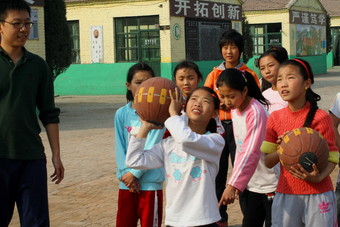
Schools as Agents of Socialization
Schools can further goals of social control by socializing students into behaving in socially acceptable ways.
Enforcement
Social control may be enforced using informal sanctions, which may include shame, ridicule, sarcasm, criticism and disapproval. In extreme cases sanctions may include social discrimination and exclusion. For example, schoolmates may enforce gender norms by ridiculing boys who undertake actions considered feminine, such as writing poetry or dancing. Informal sanctions can have a powerful effect; individuals internalize the norm, which becomes an aspect of personality.
Social control may also be enforced using formal sanctions. Formal sanctions may be used in a large group in which an individual can choose to ignore the sanctions of other individuals. This form of control usually takes the form of government action. Government and organizations use law enforcement mechanisms and other formal sanctions, such as fines and imprisonment. In schools, formal sanctions may include detention, suspension, or other formal punishments.
By means of social control, students are taught the boundaries of acceptable behavior. They carry these lessons with them into everyday life and, later, into careers. Thus, the social control lessons learned in school may prepare students, for example, to be a docile proletariat in a capitalist economy.

Social Control
Signs warning of prohibited activities; an example of social control
13.5.2: Tracking Systems
Tracking sorts students into different groups depending on academic ability; however, other factors often influence placement.
Learning Objective
Analyze the characteristics, advantages, and disadvantages of tracking systems for students
Key Points
- According to the conflict perspective, capitalism requires that many students be trained to join the working class while a few must be trained to join the ruling capitalist class. One way schools screen and allocate classes of students is by sorting them into different tracks.
- In a tracking system, students are educated with other students of the same ability level and their education differs depending on the track to which they are assigned.
- Tracking systems vary by extent, specificity, and flexibility. Traditionally, students were divided into academic, general, and vocational tracks.
- Advantages of tracking may include the ability of teachers to focus instruction, the potential for students only to be compared to others of similar ability, and the opportunity for high-achieving students to advance more quickly.
- Disadvantages of tracking may include tracking based on student background instead of ability, poor quality of instruction in lower tracks, and stigmatization of students in lower tracks.
- Detracking has been proposed as a more equitable alternative to tracking.
Key Terms
- tracking
-
An educational system in which the entire school population is assigned to classes according to whether the students’ overall achievement is above average, normal, or below average and in which students attend academic classes only with students whose overall academic achievement is the same as their own.
- Conflict Perspective
-
perspectives in social science based on Conflict Theory, that emphasize the social, political, or material inequality of a social group.
- allocating
-
setting aside for a purpose
Example
- Gamoran’s study (1992) shows that students are more likely to form friendships with other students in the same tracks than students outside of their tracks. Since low-class and minority students are overrepresented in low tracks with Whites and Asians generally dominating high tracks, interaction among these groups can be discouraged by tracking.
From the conflict perspective, schools play a role in screening and allocating people and their abilities. Advanced capitalist economies require that many students be trained to join the working class while a few must be trained to join the ruling capitalist class. One way schools may begin to sort and differently train classes of students is by sorting them into different tracks.
Tracking sorts and separates students by academic ability. In a tracking system, the entire school population is assigned to classes according to whether the students’ overall achievement is above, at, or below what is average. Students attend academic classes only with students whose overall academic achievement is the same as their own. Tracking is one of the predominant organizing practices of American public schools, and has been an accepted feature in the country’s schools for nearly a century.
Characteristics
Defined tracks often mirror class divisions in society. Thus, traditionally, students were tracked into academic, general, and vocational tracks. Academic tracks prepare students for advanced study and professions such as medicine or law, whereas general and vocational tracks were meant to prepare students for middle or working class life. Students in academically advanced tracks study higher mathematics, more foreign languages, and literature. Students in less academic tracks acquire vocational skills such as welding or cosmetology, or business skills, such as typing or bookkeeping. Students are usually not offered the opportunity to take classes deemed more appropriate for another track, even if the student has a demonstrated interest and ability in the subject. Today, few schools use tracking systems that so overtly differentiate upper, middle, and working class skills. Instead, many secondary schools now base track levels on course difficulty, with tracks such as basic, honors, or college-prep.
Tracking systems vary widely in their characteristics. Some may extend to the entire school system so that students follow a track that begins in elementary school and continues until high school graduation. Other schools may use tracking only for certain classes or subjects. Systems may also vary in their flexibility and the opportunities for mobility given to students. In some cases, placement is based entirely on student preferences. In other cases, test scores may be used to determine a student’s track. Counselors may also work with students to choose a particular class that in turn puts them on a given track. Parents and peers may influence academic choices even more than guidance counselors by encouraging students with similar backgrounds (academic, vocational, ethnic, religious, or racial) to stay together. Other times, students are placed into tracks without any knowledge or input into the process.
Advantages
Proponents of tracking say that tracking allows teachers to better direct lessons toward the specific ability level of the students in each class. Research suggests that tracking produces substantial gains for gifted students in tracks specially designed for the gifted and talented, meeting the need for highly gifted students to be with their intellectual peers in order to be appropriately challenged. However, average and low achieving students may benefit more from being in a mixed ability classroom.
Since tracking separates students by ability, students’ work is only compared to that of similar-ability peers. Thus, tracking may have emotional benefits for students: it may prevent damage to self-esteem that could result from comparisons with the work of higher ability students or inflating the egos of the high-ability students when compared to low-ability students. Tracking can also encourage low-ability students to participate in class. Since high self-esteem is correlated with high academic achievement, tracking should, theoretically, promote academic success. However, the awareness by the student of being placed into a low track might lower self-esteem, counteracting this benefit.
Disadvantages
From the conflict perspective, tracking’s primary function is not necessarily to promote learning; it is the allocation of students into specific areas of the labor market. Although track assignment is theoretically based on academic ability, other factors often influence placement. When tracking is based not on ability but instead on student background, it becomes a form of segregation and discrimination. Students in lower tracks may receive poorer quality instruction, with less-experienced teachers being assigned to low-track classes. Lessons taught in low-track classes often lack the engagement and comprehensiveness of the high-track lessons, putting low-track students at a disadvantage for college because they do not gain the knowledge and skills of the upper-track students.
Tracking can also result in a stigmatization of low-track students. This stigmatization can have a negative impact on students’ academic performance; for example, students placed in low tracks may lose confidence in their abilities, and their low confidence may be reinforced by teachers’ low expectations and their stigmatization by peers. Some research suggests that students in lower tracks are more likely to drop out of school or participate in criminal activities.

Vocational track
Students in a vocational track may learn skills such as wood working.
13.5.3: The Credentialized Society
Credentialism refers to the common practice of relying on earned credentials when hiring staff or assigning social status.
Learning Objective
Explain the use of credentialism in today’s society as a means of social mobility and job security
Key Points
- Credentialism is common in employment decisions, especially for white collar jobs.
- Credential inflation occurs when the value of a credential declines because too many potential employees possess the credential.
- In his 1979 book The Credential Society, sociologist Randall Collins examined the connection between credentialism and stratification.
Key Terms
- The Credential Society
-
A 1979 book by Randall Collins which argues that public schools are social institutions that teach and reward middle class values of competition and achievement.
- credential inflation
-
The process by which credentials lose value as more and more people earn a particular credential.
- society
-
a long-standing group of people sharing cultural aspects such as language, dress, norms of behavior and artistic forms
- credentialism
-
The common practice of relying on earned credentials when hiring staff or assigning social status.
Examples
- Common examples of credentials are academic diplomas, academic degrees, certifications, security clearances, and licenses.
- Besides attesting to one’s abilities, credentials may also grant the holder access to restricted areas, information, or activities. For example, security clearances and press passes are credentials that grant access to otherwise restricted areas. A medical license is a credential that grants the ability to practice an otherwise restricted activity.
Credentialism refers to the common practice of relying on earned credentials when hiring staff or assigning social status. Instead of directly evaluating an individual’s abilities, evaluators study that person’s credentials as a shortcut to estimate their competencies. Besides attesting to one’s abilities, credentials may also grant the holder access to restricted areas, information, or activities. For example, security clearances and press passes are credentials that grant access to otherwise restricted areas. A medical license is a credential that grants the ability to practice an otherwise restricted activity.
Credentials are attestations of qualification, competence, or authority issued to an individual by a third party with a relevant or de facto authority to do so. Common examples of credentials are academic diplomas, academic degrees, certifications, security clearances, and licenses . Credentials are often represented by documents, such as diplomas, certificates, or membership cards.

A diploma
A diploma is a type of credential.
The academic world makes very extensive use of credentials, such as diplomas, certificates, and degrees, in order to attest to the completion of specific training or education programs by students, and to attest to their successful completion of tests and exams. Receiving these credentials often leads to increased economic mobility and work opportunity.
Employers also commonly use credentials. For example, an employer may require a diploma, professional license, or academic degree. In a credential society, such certifications may become more important than actual skills or abilities. In some cases, employers may require formal credentials, such as an advanced academic degree, for a job that can be done perfectly well by applying skills acquired through experience or informal study. This type of credentialism is common in white-collar jobs, which require workers to have difficult-to-measure skills such as critical thinking. Rather than measure or evaluate those skills directly, employers assume that anyone able to earn a credential must possess those skills.
Credential Inflation
Over time, credentials may lose value, especially as more and more people earn that credential. This process is referred to as credential inflation. When credentials are inflated, they give individuals less advantage on the job market. A good example of credential inflation is the decline in the value of the U.S. high school diploma since the beginning of the twentieth century, when it was held by less than 10% of the population. At the time, high school diplomas attested to middle-class respectability, and for many years even provided access to managerial level jobs. More recently, however, the high school diploma barely qualifies the graduate for manual or menial service work.
Another indicator of credential inflation is the relative decline in the wage differential between those with college degrees and those with only high school diplomas. Jobs that were open to high school graduates a century ago now routinely require not just a bachelor’s degree, but a master’s degree as well—without an appreciable change in required skills.
The Credential Society
According to sociologist Randall Collins, understanding credentialism can help explain class-based differences in educational attainment. In his 1979 book The Credential Society, Collins argued that public schools are socializing institutions that teach and reward middle class values of competition and achievement. In this system, Anglo-Protestant elites are selectively separated from other students and placed into prestigious schools and colleges, where they are trained to hold positions of power. By teaching middle class culture through the public education system, the elite class ensures a monopoly over positions of power, while others acquire the credentials to compete in a subordinate job market and economy. In this way, schools of medicine, law, and elite institutions have remained closed to members of lower classes.
13.5.4: The Hidden Curriculum
To succeed in college, students must learn a second, hidden curriculum to meet unstated academic and social norms.
Learning Objective
Examine Synder’s idea of hidden curriculum and the effects it has on students and professors in higher education
Key Points
- In 1970, Benson Snyder, a dean at the Massachusetts Institute of Technology, published a book called The Hidden Curriculum.
- According to Snyder, the hidden curriculum goes beyond the explicit demands of the formal curriculum.
- Creativity and wonder are stifled as students shift their exclusive focus to earning high grades and giving correct answers.
- As a result of conflict over the hidden curriculum, students experience intense personal anxiety, depression, and alienation.
Key Terms
- selective negligence
-
A strategy adopted by students to succeed in education, in which they selectively neglect portions of their formal schoolwork in order to glance at all of it.
- The Hidden Curriculum
-
A book published in 1970 by Benson Snyder, a dean at the Massachusetts Institute of Technology, that argues that the college experience is inherently marked by conflict between students and instructors as students struggle to meet unstated academic goals.
- curriculum
-
The set of courses, coursework, and content, offered at a school or university.
Example
- To succeed, students must adapt and often resort to ploys and stratagems to cope with the requirements they face. For example, students may adopt a strategy of selective negligence. within the first month of classes, many students discover they cannot conceivably complete all the work assigned them; consequently, they must selectively neglect portions of the formal schoolwork.
In 1970, Benson Snyder, a dean at the Massachusetts Institute of Technology, published a book called The Hidden Curriculum. In it, he argued that the college experience is inherently marked by conflict between students and instructors. In this conflict, students struggle to meet unstated academic and social norms, or a hidden curriculum. Those who master the hidden curriculum excel while those who do not often fail, no matter their academic abilities.
According to Snyder, the hidden curriculum goes beyond the explicit demands of the formal curriculum. The goals and requirements of the hidden curriculum are unstated, but inflexible. They concern not what students learn but how and when they learn. The hidden curriculum is rooted in professors’ assumptions and values, students’ expectations, and the social context in which both professors and students find themselves. To succeed, students must adapt and often resort to ploys and stratagems to cope with the requirements they face. For example, students may adopt a strategy of selective negligence. Within the first month of classes, many students discover they cannot conceivably complete all the work assigned them; consequently, they must selectively neglect portions of the formal schoolwork. Education becomes a grueling competition rather than an enjoyable quest for knowledge. Creativity and wonder are stifled as students shift their exclusive focus to earning high grades and giving correct answers. Students, Snyder maintains, increasingly view their education as a type of game they must master.
As a result of conflict over the hidden curriculum, students experience intense personal anxiety, depression, and alienation. Some, even the most gifted, are turned off to education altogether. Students may feel frustration and anger at professors who deny them high grades, who object to creativity, and who demand that students fall in line with the hidden curriculum. But typically students must contain this anger or direct it inward. Students may judge themselves harshly, and those judgments may be reinforced by peers and professors.
No part of the university community, writes Snyder, desires the end result created by this process. The professors, too, are distracted and pressured, whether by the need to maintain institutional prestige or by the sheer frenzy of activity interrupting their creative cycles. Yet everyone, professors included, becomes locked into the competition.
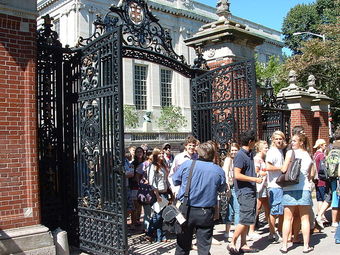
Opening Convocation at Brown University
These students are just beginning their college education, where they may also have to learn a hidden curriculum.
13.5.5: Tilting the Tests: Discrimination by IQ
IQ is meant to measure intelligence but its validity as a measure of intelligence has been debated.
Learning Objective
Discuss the various explanations for the IQ gap, ranging from genetic to environmental factors
Key Points
- The concept of intelligence itself may be culturally variable.
- Although some find evidence of a race-based IQ gap, others argue that race is not a causal variable and that race-based IQ differences are in fact caused by other differences correlated with race, such as health, wealth, and educational disparities.
- Socioeconomic status can affect many aspects of life, and therefore seems like a likely environmental influence on intelligence.
- Systemically disadvantaged minorities, such as the blacks in the United States, generally perform worse in the educational system and in intelligence tests than the majority groups or less disadvantaged minorities.
- Several studies have proposed that a large part of the IQ gap can be attributed to differences in quality of education.
- Peer groups and family can influence behavior and values.
- Peer groups and family can influence behavior and values.
Key Terms
- IQ gap
-
The gap in average IQ scores between populations, usually measured along racial lines, though with much disagreement.
- Environmental factors
-
Factors that come from one’s environment, upbringing, or social situation, rather than biology.
- intelligence
-
Capacity of mind, especially to understand principles, truths, facts or meanings, acquire knowledge, and apply it to practice; the ability to learn and comprehend.
Examples
- Some researchers have raised more serious questions about the validity of IQ tests for measuring intelligence, especially across cultures. For example, IQ tests may be inappropriate for measuring intelligence in non-industrialized communities, because they focus on modern, rational-style thinking, a type of reasoning that is common in the modern industrial West but may be alien to other cultures.
- Furthermore, the relationship between genetics and environmental factors is likely complicated. For example, the differences in socioeconomic environment for a child may be due to differences in genetic IQ for the parents, and the differences in average brain size between races could be the result of nutritional factors.
Intelligence is commonly measured using intelligence quotient (IQ) tests, which are meant to be a general measure of intelligence. However, IQ tests only measure a narrow band of the broad spectrum of intelligence, excluding factors such as creativity or emotional intelligence. Some researchers have raised more serious questions about the validity of IQ tests for measuring intelligence, especially across cultures. For example, IQ tests may be inappropriate for measuring intelligence in non-industrialized communities, because they focus on modern, rational-style thinking, a type of reasoning that is common in the modern industrial West but may be alien to other cultures. Although some find evidence of a race-based IQ gap, others argue that race is not a causal variable and that race-based IQ differences are in fact caused by other differences such as health, wealth, and educational disparities.
The IQ Gap
In the United States, IQ tests have consistently demonstrated a significant degree of variation between different racial groups. On average, IQ scores are highest among Asian Americans, lower among whites, and lowest among blacks. Yet these IQ gaps are only observed in average scores and say very little about individuals. Plus, IQ scores show considerable overlap between these group scores, and individuals of each group can be found at all points on the IQ spectrum. Thus, the implications of the IQ gaps are unclear. And while the existence of racial IQ gaps is well-documented, researchers have not reached a consensus as to their cause. In general, explanations fall into one of two camps: genetic explanations and environmental explanations.
Genetic Explanations
Explanations of ethnically innate intelligence were fairly common early in the twentieth century, with the rise of the American eugenics movement. But after World War II, they quickly fell out of favor over fear of being associated with Nazism. Today, even those who believe intelligence may have some genetic component tend to acknowledge the importance of environmental effects as well.
Many researchers are reluctant to adopt genetic explanations of the IQ gap because of their historical and political implications. The connection between race and intelligence has been a subject of debate in both popular science and academic research since the inception of intelligence testing in the early twentieth century. But even before IQ tests were invented, claims of race-based intelligence gaps were used to justify colonialism, slavery, and racial eugenics. In the late nineteenth and early twentieth centuries, much of the “scientific” evidence for racial intelligence gaps came from measurements such as brain size or reaction times.
The first IQ test was created between 1905 and 1908 and revised in 1916, during a time when Americans were quite concerned about an influx of new immigrants. Different nationalities were sometimes thought to comprise different races, especially nationalities newer to the United States, such as the Irish, the Slavs, and the Italians. Alfred Binet, the developer of these tests, warned that they should not be used to measure innate intelligence or to label individuals . Despite his warnings, the tests were used to evaluate draftees for World War I, and researchers found that people of southern and eastern European backgrounds scored lower than native-born Americans. At the time, such data was used to construct an ethnically based social hierarchy, one in which immigrants were rejected as unfit for service and mentally defective. It was not until later that researchers realized that lower language skills by new English speakers affected their scores on the tests.

Alfred Binet
Alfred Binet was a French psychologist who invented the IQ test.
Environmental Explanations
Researchers have suggested a wide array of environmental factors that might influence intelligence. In general, these factors are not mutually exclusive with one another: more than one of them may come into play at the same time. In fact, some may even directly contribute to others. Furthermore, the relationship between genetics and environmental factors is likely complicated. For example, the differences in socioeconomic environment for a child may be due to differences in genetic IQ for the parents, and the differences in average brain size between races could be the result of nutritional factors.
Socioeconomic Environment
Socioeconomic status can affect many aspects of life, and therefore seems like a likely environmental influence on intelligence. People who grow up in a community with lower socioeconomic status may have fewer enrichment opportunities (like going to museums) or a less stimulating home environment, as well as unequal access to health care, nutritious food, and quality education. But research suggests that differences in socioeconomic status cannot entirely explain the IQ gap. In part, this is because the effects of socioeconomic status are hard to isolate and measure, and are probably not independent of intelligence itself.
13.5.6: Staking the Desk: Unequal Funding
Because schools are funded by property taxes, schools in poor areas receive less funding then schools in wealthier areas.
Learning Objective
Examine the inequality in public school systems and the implications for a student’s future
Key Points
- In the United States, most public schools are funded primarily through local property taxes.
- According to the American dream, children should be able to use their education to achieve upward mobility.
- Educational deficits resulting from inequality also affect future life trajectories.
- Colleges tend to draw students from a relatively advantaged background because of their high costs and stiff academic requirements for enrollment.
- Because colleges want to maintain their rankings in various college ranking systems, colleges favor students with higher standardized test scores and aggressively recruit them using “merit” scholarships.
Key Terms
- public school
-
A publicly administered school.
- Upward mobility
-
A change in a person’s social status resulting in that person rising to a higher position in the status system.
- property taxes
-
Taxes levied by the government on landowners’ property.
Example
- In 2000, affluent students, students who could otherwise afford to pay for college, received “merit” scholarships worth 82% of the need-based aid received by students with the lowest family incomes.
In the United States, most public schools are funded primarily through local property taxes. As a result, schools in wealthier neighborhoods have substantially larger budgets, which translates into better facilities, better teachers, and better resources. Whereas some people laud education as the great equalizer, others observe the effects of school funding schemes and conclude that they actually reinforce inequality and stratification. According to the American dream, children should be able to use their education to achieve upward mobility. But unequal school funding may afford students from poorer families fewer opportunities, reinforcing the status quo.
Educational deficits resulting from inequality also affect future life trajectories. Colleges tend to draw students from a relatively advantaged background because of their high costs and stiff academic requirements for enrollment. What’s more, because colleges want to maintain their rankings in various college ranking systems, colleges favor students with higher standardized test scores and aggressively recruit them using “merit” scholarships. In 2000, affluent students, students who could otherwise afford to pay for college, received “merit” scholarships worth 82% of the need-based aid received by students with the lowest family incomes. In other words, affluent students who can pay for college often do not have to because the advantages they received attending better elementary, middle, and high schools translated into higher standardized test scores, which are attractive to universities when it comes to recruiting. As a result, there is less funding available for students who actually need it. This ends up reinforcing the existing status hierarchy by keeping the affluent wealthy, and the poor unable to attend college.

Property Tax and School Funding
Since school funding is often based on property taxes, poorer neighborhoods may have less money available for schools.
13.5.7: The Bottom Line: Family Background
Student achievement is highly correlated with family characteristics, including household income and parental educational attainment.
Learning Objective
Examine the various factors within family background that give students an advantage in the educational realm
Key Points
- Wealthy students benefit from family background characteristics.
- The monetary advantages of unequal school funding are frequently coupled with the advantage of having a safe, supportive, and intellectually enriching home environment that comes with wealth.
- Educational deficits resulting from inequality also affect future life trajectories. Colleges tend to draw students from a relatively advantaged background because of their high costs and stiff academic requirements for enrollment.
Key Terms
- household income
-
The total income of all members of a household.
- parental educational attainment
-
The level of education achieved by one’s parents.
Example
- Children who attend better-funded public schools tend to be more successful than those who attend more poorly funded public schools.
Not only do wealthier students tend to attend better-funded schools, but they often also benefit from family background characteristics. The monetary advantages of unequal school funding are frequently coupled with the advantage of having a safe, supportive, and intellectually enriching home environment that comes with wealth. So it is not surprising that children who attend better-funded public schools tend to be more successful than those who attend more poorly funded public schools.
In fact, family background may be even more important than school funding. Evidence suggests that the lifetime educational possibilities of most kids are set by the time they are six years old. This is due to the fact that several family background characteristics are very strong predictors of future educational attainment, including parental support, parental expectations for schooling, household income, and parental educational attainment, with the last two being the most important factors. Researchers can actually predict a child’s lifetime educational attainment by using background characteristics observed when the child is in the first grade, and these predictions turn out to be just as good, or even better, at predicting educational attainment as similar predictions based on observations made when the student is in high school.
Educational deficits resulting from inequality also affect future life trajectories. Colleges tend to draw students from a relatively advantaged background because of their high costs and stiff academic requirements for enrollment. What’s more, because colleges want to maintain their rankings in various college ranking systems (e.g., U.S. News & World Report), colleges favor students with higher standardized test scores and aggressively recruit them using “merit” scholarships. In 2000, affluent students, students who could otherwise afford to pay for college, received “merit” scholarships worth 82% of the need-based aid received by students with the lowest family incomes.
13.6: The Symbolic-Interactionist Perspective on Education
13.6.1: Ray Rist’s Research
Ray Rist, a sociologist, found that social class contributed to the perceptions of teachers and was a predictor of scholastic success.
Learning Objective
Examine the relationship between social class and academic achievement
Key Points
- In 1970, Ray Rist published a study on the relationship between the socioeconomic status of children and their educational evaluation.
- In his study, Rist observed how a classroom teacher placed her students in three learning groups. The “fast learners” were grouped at the front of the class, while the “slow learners” sat at the back.
- Interestingly, Rist noticed that social class was a predictor of placement. Middle class students made up the group of “fast learners,” while lower class students made up the other two groups.
- From his data, Rist concluded that each child’s journey through school was determined by the eighth day of kindergarten. The labels given to these children by their kindergarten teacher set them on a course of action that could possibly affect the rest of their lives.
Key Terms
- Ray Rist
-
a sociologist who, in 1970, published a study on the how the socioeconomic statuses of school children could affect their educations
- self-fulfilling prophecy
-
a prediction that, by being voiced, causes itself to come true
Example
- There are a number of ways social class can affect a teacher’s perception of his or her students. A teacher might, for example, conflate sloppy dress with a general lack of organizational skills. A child from a poor household might wear lower-quality, ill-fitting, or even damaged clothing, and a teacher might interpret this as demonstrating general carelessness on the part of the child. This type of subconscious assessment can lead a teacher to underestimate a poor student’s diligence and skill.
Ray Ristwas a sociologist who, in 1970, published a report linking the socioeconomic status of children to their educational achievement. Through observations of classrooms, Rist demonstrated that a student’s socioeconomic status affected how teachers perceived that student’s aptitude at very early ages. These early perceptions came to inform how the students viewed themselves, and had impacts on their eventual educational success.
Social Class and Academic Success
Although public schools are free and open to all children, there are still educational setbacks for children of a lower social class. In his 1970 article, “Student Social Class and Teachers’ Expectations: The Self-Fulfilling Prophecy of Ghetto Education,“ Ray Rist observed an African American classroom with an African American teacher. He discovered that after only eight days in the classroom, the teacher felt that she knew her students’ abilities well enough to assign them to separate worktables. To Table One, she assigned those she considered “fast learners.” These students sat at the front of the class, closest to her. “Average” students were placed at Table Two, and the “slow learners” were placed at Table Three in the back of the classroom.
Interestingly, Rist found that social class was the underlying basis for assigning the children to the different tables. Middle class students were placed at Table One, while children from poorer homes were placed at the other two tables. During class, the teacher paid the most attention to the children closest to her, less to Table Two, and least to Table Three. As the year went on, the children at Table One perceived that they were treated better and started viewing themselves as smarter than their peers. They emerged as leaders in class activities and even ridiculed the children at the other tables, calling them “dumb.” Eventually, the children at Table Three stopped participating in classroom activities. By the end of the year, the only children who were satisfactorily completing the daily lessons were those at Table One.
The Eighth Day of Kindergarten
Following the initial year, Rist continued to observe this group of students as they advanced in school. The children’s reputations followed them into second grade, where another teacher reviewed their scores and also divided her class into three groups, the “Tigers,” “Cardinals,” and “Clowns.” These groups were constituted the exact same way, and with the exact same breakdown, as Tables One, Two, and Three. From this research, Rist made the startling conclusion that each child’s journey through school was determined by the eighth day of kindergarten. According to Rist, the labels given to children by their kindergarten teachers set them on a course of action that could possibly affect the rest of their lives .
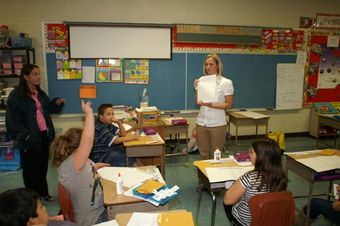
Students with teacher
Rist’s research showed that teachers judge their students’ abilities after only eight days in the classroom.
13.6.2: Teachers’ Expectations
Teachers’ perception of students’ knowledge and abilities influences classroom processes and student achievement.
Learning Objective
Discuss how a teacher’s perception influences student performance, in terms of expectations and gender stereotypes
Key Points
- The Pygmalion effect refers to the phenomenon in which the greater the expectation placed upon people (such as children, students, or employees) the better they perform.
- The Pygmalion effect is a form of self-fulfilling prophecy.
- Within sociology, the effect is often cited with regard to education and social class.
- Gender stereotyping within classrooms can also lead to differences in academic achievement and representation for female and male students.
Key Terms
- Gender Stereotyping
-
When one believes that an individual will behave in a particular way simply because of his or her sex.
- Pygmalion effect
-
The phenomenon in which the greater the expectation placed upon people (often children, students, and employees), the better they perform.
- self-fulfilling prophecy
-
a prediction that, by being voiced, causes itself to come true
Examples
- The Pygmalion effect was famously applied to the classroom in the Rosenthal-Jacobson study, published in 1968. In this study, Robert Rosenthal and Lenore Jacobson showed that if teachers were led to expect enhanced performance from some children, then the children did indeed show that enhancement.
- Teachers usually have higher expectations for students they view as higher achievers and treat these students with more respect. For example, studies have found that when students are split into ability-based groups, the students in the higher-ability groups are more likely to demonstrate positive learning behaviors and higher achievement.
- Gender stereotyping within classrooms can also lead to differences in academic achievement and representation for female and male students. Math and science are often perceived as “masculine” subjects because they lead to success in “masculine” fields, such as medicine and engineering. English and history, on the other hand, are often perceived as “feminine” subjects because they are more closely aligned with “feminine” jobs, such as teaching or care work.
How teachers perceive students’ knowledge and abilities influences classroom processes and student achievement. In other words, when teachers believe students will be high achievers, those students achieve more; conversely, when teachers believe students will be low achievers, those students tend to achieve less. This is a case of a self-fulfilling prophecy, or the Pygmalion effect.
The Pygmalion Effect
The Pygmalion effect refers to the phenomenon in which the greater the expectation placed upon people (often children or students and employees) the better they perform. The effect is named after Pygmalion, a Cypriot sculptor in a narrative by Ovid in Greek mythology, who fell in love with a female statue he had carved out of ivory after it became human due to his wishes. The Pygmalion effect is a form of self-fulfilling prophecy, and, in this respect, people will internalize their negative label, and those with positive labels succeed accordingly. Within sociology, the effect is often cited with regard to education and social class.
The Pygmalion effect was famously applied to the classroom in the Rosenthal-Jacobson study, published in 1968. In this study, Robert Rosenthal and Lenore Jacobson showed that if teachers were led to expect enhanced performance from some children, then the children did indeed show that enhancement. This influence can be beneficial as well as detrimental depending on which label an individual is assigned. The purpose of their study was to support the hypothesis that reality can be influenced by the expectations of others. Rosenthal posited that biased expectancies can essentially affect reality and create self-fulfilling prophecies as a result. In this experiment, Rosenthal predicted that, when given the information that certain students had higher IQs than others, elementary school teachers may unconsciously behave in ways that facilitate and encourage the students’ success.
Gender Stereotyping
How might teachers’ expectations create a Pygmalion effect? Teachers usually have higher expectations for students they view as higher achievers, and treat these students with more respect. For example, studies have found that when students are split into ability-based groups, the students in the higher-ability groups are more likely to demonstrate positive learning behaviors and higher achievement. Teachers’ expectations may also be gendered, perhaps explaining some of the gender achievement gap. Gender stereotyping within classrooms can also lead to differences in academic achievement and representation for female and male students. Math and science are often perceived as “masculine” subjects because they lead to success in “masculine” fields, such as medicine and engineering. English and history, on the other hand, are often perceived as “feminine” subjects because they are more closely aligned with “feminine” jobs, such as teaching or care work. Research on the stereotype threat has shown that gender stereotypes decrease the mathematical self-esteem of many female students, and that this lack of academic confidence leads to anxiety and poorer performance on math exams. Therefore, these stereotypes can influence student achievement in these areas.
Gender-specific evaluations from teachers are implicit; usually the teachers have no idea that they are favoring one gender over the other until they are shown concrete evidence, such as a video recording of their classroom. However, even though the discrimination is implicit, it still has negative effects on both male and female students.

Teacher-student Monument
The teacher-student monument in Rostock, Germany honors teachers.
13.7: Issues in the U.S. Education System
13.7.1: Unequal Access to Education
Access to education varies by geographic location, race, gender, and class.
Learning Objective
Describe the upsides and downsides to the current educational system in the U.S.
Key Points
- In the United States, as in most countries, people with more education tend to enjoy higher economic status, power, prestige, and levels of income.
- Dropout rates are higher in certain locations and among minorities.
- In some areas, the best high schools are private high schools that may be out of reach for poorer students who cannot afford the tuition.
- U.S. public schools lag behind the schools of other developed countries in the areas of reading, math, and science.
Key Terms
- minority
-
Categories of persons who hold few or no positions of social power in a given society.
- dropout rates
-
Dropout rates are a measurement of the proportion of students who drop out, that is, who leave a school for practical reasons, necessities, or disillusionment with the system from which the individual in question leaves.
Examples
- In high school, economic, family, and social demands may lead some students to drop out before finishing. Thus, sociologists have observed that dropout rates vary among different social groups. For instance, dropout rates are lowest among Asian Americans, followed closely by whites. But Hispanic, black, and Native American students drop out at rates nearly double those of Asian and white students. Overall, the dropout rate has been declining for decades, since at least the 1970s, yet it remains disproportionately high for minority students.
- According to a 2005 report from the OECD, the United States is tied for first place with Switzerland when it comes to annual spending per student on its public schools, with each of those two countries spending more than $11,000 per student. However, the United States is ranked 37th in the world in education spending as a percentage of gross domestic product. All but seven of the leading countries are in the third world and ranked high because education spending makes up proportionally more of a low GDP.
In the United States, as in most countries, people with more education tend to enjoy higher economic status, power, prestige, and levels of income. One might expect, then, that all people would try to maximize their education. After all, education is meant to be the great equalizer by which anyone can climb the rungs of the social hierarchy. However, evidence suggests that certain groups have unequal access to education.
In the United States, public schools provide free education through 12th grade, but post-secondary college education is not free. Costs include tuition and room and board, even at public institutions. Those who are unable to afford the expense of college, therefore, have unequal access. According to a 2005 report from the OECD, the United States is tied for first place with Switzerland when it comes to annual spending per student on its public schools, with each of those two countries spending more than $11,000. However, the United States is ranked 37th in the world in education spending as a percentage of gross domestic product. All but seven of the leading countries are in the third world, ranked high because of a low GDP. U.S. public schools lag behind the schools of other developed countries in the areas of reading, math, and science.
Even in high school, economic, family, and social demands may lead some students to drop out before finishing. Thus, sociologists have observed that dropout rates vary among different social groups. For instance, dropout rates are lowest among Asian Americans, followed closely by whites. But Hispanic, black, and Native American students drop out at rates nearly double those of Asian and white students. Overall, the dropout rate has been declining for decades, since at least the 1970s, yet it remains disproportionately high for minority students.
School funding varies by geographic location. In part, the disparities in dropout rates may be a symptom of disparities in access to high quality education. In some areas, the best high schools are private high schools that may be out of reach for poorer students who cannot afford the tuition. Even public schools may receive different rates of funding; in particular, schools in poorer areas tend to receive less funding because school funding is often tied to property taxes. Thus, students who live in poorer areas may have less access to high quality education. One of the biggest debates in funding public schools is funding by local taxes or state taxes. The federal government supplies around 8.5% of the public school system funds, according to a 2005 report by the National Center for Education Statistics. The remaining split between state and local governments averages 48.7% from states and 42.8% from local sources. However, the division varies widely. In Hawaii local funds make up 1.7%, while state sources account for nearly 90.1%.
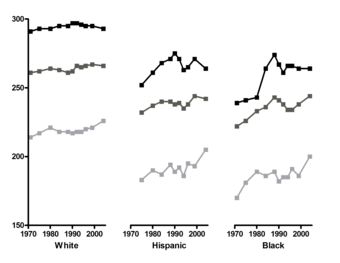
Trends in reading scores by race, 1970–2004
Reading- ages 9 (light gray), 13 (dark gray), and 17 (black). Trends in reading scores collected by the National Assessment of Educational Progress (NAEP), with the light-gray line indicating data collection at age 9, dark-gray at age 13, and black at age 17. White, hispanic, and black students all improved their reading scores as they aged. Notably, however, the achievement gap between white vs. black and hispanic students has narrowed over time but has by no means disappeared; white students still show the highest achievement in reading.
13.7.2: English as a Second Language
English as a second language (ESL) refers to the use or study of English by speakers with different native languages.
Learning Objective
Describe some of the difficulties and challenges facing ELL students in the U.S.
Key Points
- English language learners (ELL) must learn to speak and write English in addition to learning substantive content in schools.
- ELL students are often tracked with lower ability students because they have lower standardized test scores, which may inaccurately measure their academic ability.
- ELL students are more likely to drop out. In the U.S., schools may let ELL and other low-scoring students drop out in order to raise average test scores.
- ELL students may have trouble earning the English credits necessary to be accepted into college.
- On average, ELL students come from poorer families than native speakers, which presents an additional barrier to college.
- ESL programs may help ELL students form friendships and encourage social interaction, tolerance, and multicultural values.
- ESL programs may help ELL students form friendships and encourage social interaction, tolerance, and multicultural values.
Key Terms
- Standardized Test Scores
-
A standardized test is a test that is administered and scored in a consistent, or “standard”, manner.
- native speaker
-
A person who grew up with a particular language as their mother tongue.
- tolerance
-
The ability or practice of tolerating; an acceptance or patience with the beliefs, opinions or practices of others; a lack of bigotry.
Example
- In the U.S. over the last twenty years, more than 70% of non-English-speaking school-age immigrants have arrived in the U.S. before they were 6 years old. At this age, they could have been taught English in school and achieved a proficiency indistinguishable from a native speaker. In other countries, such as Russia, France, Spain, and Germany, this approach has dramatically improved reading and math test scores for linguistic minorities.
English as a second language (ESL), English for speakers of other languages (ESOL) and English as a foreign language (EFL) all refer to the use or study of English by speakers with different native languages. Generally, English Language Learners (ELL) are refugees, immigrants, or their children. They must learn English as a Second Language (ESL) in order to function in their new host country. In the U.S. over the last twenty years, more than 70% of non-English-speaking school-age immigrants have arrived in the U.S. before they were 6 years old. At this age, they could have been taught English in school, and achieved a proficiency indistinguishable from a native speaker. In other countries, such as the Russia, France, Spain, and Germany this approach has dramatically improved reading and math test scores for linguistic minorities. Supporters of ESL programs claim they play an important role in the formation of peer networks and adjustment to school and society in their new homes. Having class among other students learning English as a second language relieves the pressure of making mistakes when speaking in class or to peers. ESL programs also allow students to meet and form friendships with other non-native speakers from different cultures, promoting racial tolerance and multiculturalism.
Potential Academic Barriers for ELL Students
Nevertheless, ELL students face predictable difficulties in learning English. Those whose native languages are drastically different from English may find it especially difficult to learn the sounds and grammar of English, while others whose native languages are more similar may have less trouble. But these students also face difficulties unrelated to learning the language itself, including the possibility of having their abilities underestimated, a higher probability of dropping out, difficulty paying for and succeeding in college, and social problems connecting with native speakers. ELL students are often tracked with lower ability students because they have lower standardized test scores, which may inaccurately measure their academic ability.
ELL students are also more likely to drop out of high school. Their higher dropout rates may be due to difficulties in keeping up in mainstream classes or to prior interruptions in their formal education. For example, some ELL students may have spent time in refugee camps where they had no opportunity to attend school. Further, some have speculated that school administrators may actually encourage ELL students to drop out because it may increase the school’s overall average test scores, which may in turn benefit the school (e.g., by ensuring continued funding).
ELL students face additional barriers to pursuing higher education. Most colleges and universities require four years of English in high school, but many will accept only one year of ESL English. ELL students who arrive in the United States relatively late may find it difficult to meet this requirement because they must spend a longer time in ESL English classes in high school, or because they might not arrive early enough to complete four years of English in high school. Consequently, some ELL students lack the required credits to apply for college.
ELL students can also face financial barriers to higher education. Those who do not place high enough on college placement exams often have to enroll in ESL courses at their universities. Often, they must pay fees for these courses in addition to tuition, and these courses may not count as credit towards graduation. These additional fees add to the financial burden faced by ELL students who often come from families of lower socioeconomic status. The latest statistics show that the median household income for school-age ELL students is $36,691 while that of non-ELL students is $60,280.
ELL students often have difficulty interacting with native speakers. ELL students may avoid interactions with native speakers because they are frustrated with or embarrassed by their English ability. Immigrant students often also lack knowledge about popular U.S. culture, which limits their conversations with native speakers to academic topics. In classroom group activities with native speakers, ELL students often do not participate, again because of embarrassment of their English, but also because of cultural differences which value silence and individual work at school over social interaction and talking in class. These interactions have been found to extend to teacher-student interactions as well. In most mainstream classrooms, teacher-led discussion is the most common form of lesson. In this setting, ELL students will fail to participate, and often have difficulty understanding teachers because they talk too fast, do not use visual aids, or use native colloquialisms. ELL students also have trouble getting involved with extracurricular activities with native speakers for similar reasons. Students fail to join extra-curricular activities because of the language barrier, cultural emphasis of academics over other activities, or failure to understand traditional pastimes in their new country.
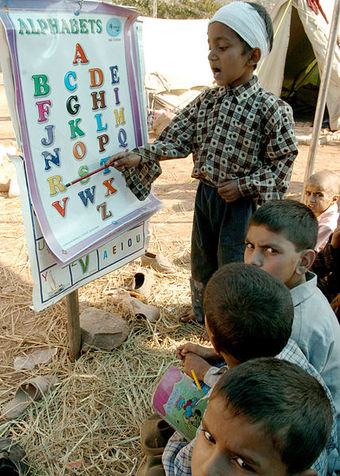
Displaced Pakistani children learn English as a second language
Displaced Pakistani children located at the Dewan Tent Village attend school in Muzaffarabad, Pakistan. Children are taught English as their second language in the 3rd grade. The United States is participating in a multi-national assistance and support effort led by the Pakistani Government to bring aid to the victims of the devastating earthquake that struck the region on October 8th, 2005. U.S. Navy photo by Photographer’s Mate 2nd Class Eric S. Powell
13.7.3: High School Dropouts
While education can improve life chances, not everyone has equal access to education.
Learning Objective
Recall some of the reasons why students in the U.S. may drop out of high school and the potential consequences of dropping out
Key Points
- The more education people have, the higher their income, the better their life chances, and the higher their standard of living.
- Dropout rates also vary geographically, with the lowest rates in northern states.
- The relationships students have with their peers also influence a student’s likelihood of dropping out.
Key Terms
- life chances
-
Life chances (Lebenschancen in German) is a political theory of the opportunities each individual has to improve his or her quality of life. The concept was introduced by German sociologist Max Weber. It is a probabilistic concept, describing how likely it is, given certain factors, that an individual’s life will turn out a certain way.
- Academic Risk Factors
-
Academic risk factors refer to the performance of students in school and are highly related to school-level problems. These factors include absenteeism, grade retention, special education placement, low performance and grades, and low educational expectations.
Life Chances
The more education people have, the higher their income, the better their life chances, and the higher their standard of living. In general, people with more education tend to earn higher incomes and enjoy a higher standard of living. High school dropouts are much less likely to be employed than those with high school and college degrees. Even earning a four-year degree can raise average weekly income by nearly $400.

Bobby Fischer 1960 in Leipzig
Chess legend Bobby Fischer never finished high school; however, most high school dropouts do not achieve his level of success.
Max Weber used the concept of “life chances” to express an individual’s access to employment opportunities and other resources. In part, life chances are determined by birth. An individual born into a wealthy family will have higher life chances than average because they will have access to greater opportunities from the moment they are born.
Education also offers a means to improve one’s life chances by improving employment opportunities and making social connections. Thus, the consequences to dropping out can be high, as they significantly decrease the opportunity to improve one’s life chances. In addition to personal costs, dropping out has social costs. Dropouts have a greater likelihood of being arrested. Ultimately, this can lower the average standard of living for society as a whole. According to estimates, the average high school dropout will cost the government over $292,000.
Academic
Risk Factors
Not all students have an equal risk of dropping out. Students at risk for dropout based on academic risk factors are those who often have a history of absenteeism and grade retention, academic trouble, and more general disengagement from school life. Students may also be at risk for dropout based on social risk factors. Members of racial and ethnic minority groups drop out at higher rates than white students, as do those from low-income families, from single-parent households, and from families in which one or both parents also did not complete high school. Dropout rates also vary geographically, with the lowest rates in northern states. The highest dropout rates occur in the south and southwestern United States.
Why else might students drop out? Sociologists tend to group dropout risk factors into different categories, including academic risk factors and school-level risk factors. Academic risk factors relate to the performance of students in school. School structure, curriculum, and size may increase the exposure of students to academic risk factors. For example, students are more likely to drop out when they attend schools with less rigorous curriculum, when they attend large schools, or when they attend schools with poor student-teacher interactions.
The relationships students have with their peers also influence a student’s likelihood of dropping out. Students who build relationships with anti-social peers or who have deviant friends were more likely to drop out of school early regardless of their achievement in school. Relationships with parents can also influence a student’s decision to stay in school. The better the relationship, as demonstrated through positive interaction and parental involvement, the more likely the student will stay in school. If a student does not have a good relationship with her parents, the student is more likely to drop out even if she has good grades and good behavior.
Students who drop out of school may identify different motivations, including uninteresting classes (a lack of engagement with school life and classes), feeling unmotivated (especially by teachers who did not demand enough or were not inspirational), personal reasons (had to get a job, became a parent, had to support or care for a family member), and academic challenges (felt like they could not keep up, felt unprepared for high school, had to repeat a grade, or graduation requirements seemed out of reach).
Finally, some education researchers have noted that dropout rates may have been exacerbated by policies such as the U.S. No Child Left Behind Act that required schools to use high-stakes standardized testing as an accountability measure. These policies may have inadvertently encouraged students to drop out of high school, since teachers and administrators utilize grade retention as a strategy to improve test scores and ensure positive ratings for the school. As mentioned above, grade retention increases the likelihood that a student will drop out of school.
13.7.4: Violence in Schools
School violence is a serious problem in the United States, and attempts to explain it identify both individual and social risk factors.
Learning Objective
Recall the risk factors for school violence in the U:S. and the two types of bullying
Key Points
- Individual risk factors for school violence include a tendency to externalize problems, or act out, as well as developmental delays, low IQ, and reading problems.
- Social risk factors for school violence include an unstable home environment, violent neighborhoods, and certain characteristics of a school environment.
- A neighborhood environment may contribute to school violence when a community’s high rates of crime or drug use spills over into the classroom.
- Bullying may be committed by one student or a group of students.
- Physical bullying is the most easily identified and includes unwanted physical contact such as pushing, kicking, and tickling. It may also include the use of weapons.
- Verbal bullying is any slanderous statements or accusations that cause the victim undue emotional distress, such as insulting someone’s appearance, laughing at someone, or directing foul language toward someone.
- Emotionally bullying is any form of bullying that damages a victim’s emotional well-being, such as spreading malicious rumors, giving someone the silent treatment, or harassment.
Key Terms
- bullying
-
an act of physically or emotionally intimidating a weaker person to do something, especially through repeated coercion
- School Violence
-
School violence is widely considered to have become a serious problem in recent decades in many countries, particularly violence involving weapons. This includes violence between school students as well as physical attacks by students on school staff.
Examples
- In 2007, a nationwide survey conducted by the Center for Disease Control and Prevention found that, during the 30 days before they took the survey, 5.9% of students had carried a weapon to school and 5.5% of students had skipped school because they did not feel safe.
- Between 1996 and September 2003, at least 46 students and teachers were killed in 27 incidents involving the use of firearms.
- In 2001, students between the ages of 12 and 18 were the victims of 2 million crimes at school, and 62% of those crimes were thefts.
School violence is a serious problem in the United States. This refers to violence between students as well as physical attacks by students on school staff. In 2007, a nationwide survey conducted by the Centers of Disease Control and Prevention found that, during the 30 days before they took the survey, 5.9% of students had carried a weapon to school, and 5.5% of students had skipped school because they did not feel safe. In the 12 months before they took the survey, 12.4% of students had been in a physical fight on school property at least once. Between 1996 and 2003, at least 46 individuals were killed in 27 school incidents involving the use of firearms.
While these numbers are alarming, data also shows that most crimes at school are not violent. In 2001, students between the ages of 12 and 18 were the victims of two million crimes at school, but 62% of those crimes were thefts. In part, violence receives more attention because it draws media coverage. For example, school shootings account for less than 1% of violent crimes in public schools, yet nearly every school shooting makes national headlines. Nevertheless, because school violence can have such serious consequences, educators and policymakers take the issue very seriously.
Explanations of School Violence
Attempts to explain school violence have identified several individual and social risk factors. Individual risk factors include a tendency to externalize problems, or “act out,” as well as developmental delays, low IQ, and reading problems. Social risk factors include an unstable home environment, violent neighborhoods, and certain characteristics of a school environment. A home environment may contribute to school violence if, at home, students are exposed to gun violence, parental alcoholism, domestic violence, physical abuse, sexual abuse, or harsh parental discipline. All of these may teach children that criminal and violent activities are acceptable and may increase a child’s tendency to respond to frustration with aggression. A neighborhood environment may contribute to school violence if a community has high rates of crime or drug use. A neighborhood may also expose students to deviant peers or to gangs who contribute to violence inside schools. Finally, school violence tends to be higher in certain types of schools, the characteristics of which are listed below:
- a large male population
- higher grade levels
- a history of disciplinary problems
- a high student-to-teacher ratio
- urban location
Prevention and intervention strategies may target individual students, families, the school community, or society in general. Individual-level strategies target at-risk or aggressive students and teach these students conflict resolution, problem solving, and social skills. Family-based solutions attempt to improve family relationships in order to improve students’ experiences while they are at home. School-wide strategies are designed to modify school characteristics associated with violence. Examples of this would be classroom practices that encourage student cooperation and close interaction with teachers, or the presence of police and law enforcement in schools to discourage violence. Finally, society-level prevention strategies attempt to change social and cultural conditions in order to reduce violence, regardless of where it occurs. For example, society-level strategies might try to reduce the violence portrayed in movies or music.
Bullying
In recent years, one particular type of school violence, bullying, has garnered special attention. Bullying can be committed by one student or a group of students. Typically, a group of bullies takes advantage of, or isolates, one student in particular and gains the loyalty of bystanders who, in many cases, want to avoid becoming victims themselves. Bullies typically taunt and tease their target before physically bullying their target. The targets of bullying are often students who are considered strange or different by their peers to begin with, making the situation harder for them to deal with. Often, victims are targeted based on their appearance, their gender, or their sexual orientation.
Bullying is a common occurrence in most schools. According to the American Psychological Association, “approximately 40% to 80% of school-age children experience bullying at some point during their school careers. ” Bullying can be physical, verbal, and emotional. Physical bullying is the most easily identified and includes unwanted physical contact such as pushing, kicking, tickling, or the like, and may also include the use of weapons. Verbal bullying is any slanderous statements or accusations that cause the victim undue emotional distress. This can include insulting someone’s appearance, laughing at someone, or directing foul language toward someone. Emotionally bullying is any form of bullying that damages a victim’s emotional well-being, such as spreading malicious rumors, giving someone the silent treatment, or harassment. Bullying can also take place over the internet with text messaging. This “cyber-bullying” is particularly pernicious because it can be done anonymously, without detection by parents or authorities.
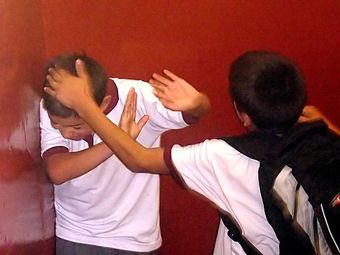
Bullying
Bullying is an increasingly recognized problem in schools.
13.7.5: Homeschooling
Home schooling is the education of children at home rather than in the setting of a school.
Learning Objective
Sketch generally the different regulations regarding homeschooling which can be found in the United States
Key Points
- Motivations for home schooling vary, but may include dissatisfaction with the school environment, religious or moral reasons, or dissatisfaction with the quality of academic instruction provided in local schools.
- The legal status of home schooling varies by states, but in all cases, homeschooled students must meet certain requirements and are subject to certain assessments to ensure the quality of education.
- Homeschooled students have varying access to resources, including extracurricular activities.
Key Term
- home schooling
-
Homeschooling or home school (also called home education or home-based learning) is the education of children at home, typically by parents but sometimes by tutors, rather than in other formal settings of public or private school.
Examples
- In the United States, about 2.9% of students, or about 1.5 million children, are homeschooled.
- Most homeschooled children are homeschooled only, but about one in five are also enrolled in public or private schools, which they may attend for 25 hours or less each week.
Homeschooling is the education of children at home, typically by parents but sometimes by tutors, rather than in other formal settings of public or private school. In the United States, about 2.9% of students, or about 1.5 million children, are homeschooled. Most homeschooled children are homeschooled only, but about one in five are also enrolled in public or private schools, which they may attend for 25 hours or less each week. By enrolling part-time at a school, homeschooled students can study subjects such as foreign languages and sciences, which may be more difficult to teach at home. They may also be eligible to participate in academic and athletic extracurricular activities.
Motivations for homeschooling vary, but may include dissatisfaction with the school environment, religious or moral reasons, or dissatisfaction with the quality of academic instruction provided in local schools. Surveys suggest that the most common motivations for homeschooling are concern about the school environment (e.g., safety, drugs, or negative peer pressure), a desire to provide religious or moral instruction, and dissatisfaction with academic instruction at other schools. Parents may also choose to homeschool children with special needs that the parent feels the school cannot or will not meet. Other, less common motivations include concerns about family time, finances, travel, and distance.
In the United States education is compulsory. Every state has some form of a compulsory attendance law that requires children in a certain age range to spend a specific amount of time being educated. The most common way for parents to meet these requirements is to have their children attend public school. However, parents have always had some degree of choice in where and how children are educated. Thus, the legality of homeschooling has been debated, and that debate has focused largely on whether it is legal for parents to withhold children from school and educate them in a home setting. Since the 1980s, the focus of the debate has shifted to questions about the distribution of resources and state control over homeschooling. The legality of homeschooling is generally accepted, but debate continues over whether homeschooling communities can access state school funds, facilities, and resources and whether the state can regulate areas like curricula and standardized testing.
Today, homeschooling is legal in all 50 states, although it is regulated in different ways by each state. Homeschooling laws can be divided into three categories. First, in some states, homeschooling is treated like a type of private school. In these states, homeschools are generally required to comply with the same laws that apply to other schools. Homeschools in California, Indiana, and Texas, for example, fall into this category. In other states, the requirements for homeschooling are set by the particular parameters of the compulsory attendance statute. These states’ compulsory attendance laws do not make any specific reference to “homeschooling. ” Homeschools in New Jersey, Maryland, for example, fall into this category. Third, in other states homeschool requirements are based on a statute or group of statutes that specifically applies to homeschooling. In these states, the requirements for homeschooling are set out in the relevant statutes. Often, these statutes refer to homeschooling by another name. For example, in Virginia it is “home instruction,” in South Dakota it is “alternative instruction,” and in Iowa it is “competent private instruction. “
States also differ in the level of resources they make available to homeschooled students. A minority of states require public schools to give homeschooled students access to district resources, such as school libraries, computer labs, extracurricular activities, or even academic courses. In some communities, homeschoolers may meet with a teacher periodically for curriculum review and suggestions. Other states give districts the option of giving homeschooled students access to such resources.
Access to interscholastic athletic competition varies from state to state. Some state athletic associations ban homeschoolers from interscholastic competition, both by prohibiting homeschoolers to compete for a state federation member school as well as by prohibiting member schools to compete against independent teams made up of homeschoolers. In such states, homeschoolers may only compete amongst other homeschoolers or against schools that are not members of the state’s interscholastic athletic federation. Other states allow homeschoolers to compete for the public schools that they would otherwise attend by virtue of their residence. Still other state interscholastic athletic associations allow homeschoolers to organize teams that compete against other established schools, but do not allow homeschoolers to compete on established school teams.

Motivations for homeschooling
Motivations regarded most important for homeschooling among parents in 2007
13.7.6: Standardized Tests
A standardized test is a test that is administered and scored in a consistent manner.
Learning Objective
Argue for or against standardized testing based on the key points attributed to proponents and critics in the text
Key Points
- Standardized tests are one common method by which schools measure students’ academic achievement, and they may also be used to measure students’ progress and teachers’ effectiveness, or in order to assess whether students are ready to progress to the next stage in their education.
- One of the main advantages of standardized testing is that the results can be empirically documented.
- Critics point out that standardized tests actually evaluate three things: what students learn in school, what they learn outside of school, and their innate intelligence.
- Critics worry that standardized tests lead teachers to “teach to the test”.
- Testing bias occurs when a test systematically favors one group over another, even though both groups may be equal on the trait the test measures.
- No Child Left Behind required that states assess educational achievement and allocate resources using standardized tests.
- Testing bias occurs when a test systematically favors one group over another, even though both groups are equal on the trait the test measures.
Key Terms
- No Child Left Behind
-
The No Child Left Behind Act of 2001 (NCLB) is a United States Act of Congress that came about as wide public concern about the state of education. NCLB is a reauthorization of the Elementary and Secondary Education Act, which included Title I, the government’s flagship aid program for disadvantaged students. NCLB supports standards-based education reform based on the premise that setting high standards and establishing measurable goals can improve individual outcomes in education.
- standardized tests
-
A standardized test is a test that is administered and scored in a consistent, or “standard”, manner.
- Testing Bias
-
Testing bias occurs when a test systematically favors one group over another, even though both groups are equal on the trait the test measures.
Example
- In 2001, the United States passed the No Child Left Behind Act, which requires all states to test students in public schools statewide to ensure that they are achieving the desired level of minimum education. Although some states already had statewide standardized testing requirements, for many states, this act required them to create new systems. Because of this, the act reinvigorated debate over the accuracy, efficacy, and justice of relying on standardized tests to measure student achievement.
Standardized tests are one common method by which schools measures students’ academic achievement. These tests may be given periodically and repeatedly to measure students’ progress and teachers’ effectiveness, or they may be given at key points during students’ careers to assess whether they are ready to progress to the next stage in their education—often, the next grade level or college. A standardized test is a test that is administered and scored in a consistent manner. They are designed so that the questions, conditions for administering, scoring procedures, and interpretations are purportedly without bias.
Proponents of Standardized Tests
One of the main advantages of standardized testing is that the results can be empirically documented; the test scores can be shown to have a relative degree of validity and reliability, being generalizable and replicable. Standardized tests allow educators, policymakers, and admissions committees easily and fairly compare results from different students. It may be difficult to account for differences in educational culture across schools, difficulty of a given teacher’s curriculum, differences in teaching style, and techniques and biases that affect grading. This makes standardized tests useful for admissions purposes in higher education, where a school is trying to compare students from across the nation or across the world.
Opponents of Standardized Tests
Critics worry that standardized tests lead teachers to “teach to the test. ” Standardized tests can be useful tools for assessing student achievement, and they can be used to focus instruction on desired outcomes, such as reading and math skills. However, critics feel that overuse and misuse of these tests harms teaching and learning by narrowing the curriculum. While it is possible to use a standardized test without letting its contents determine curriculum and instruction, frequently what is not tested is not taught, and how the subject is tested often becomes a model for how to teach the subject.
Further, standardized tests tend to measure only one sort of knowledge, while discounting creativity and diverse modes of expression. In essence, standardized tests use a one-size-fits-all theory, which is not always an effective way to measure students’ knowledge and comprehension. Students who fail standardized tests may be diagnosed with learning disabilities or disorders instead of recognized for the skills they have, which are consequently left unchallenged and undeveloped.
Finally, critics have expressed concern that standardized tests may create testing bias. Testing bias occurs when a test systematically favors one group over another, even though both groups are equal on the trait the test measures. Critics allege that test makers and facilitators tend to represent a middle class, white background and standardized testing matches the values, habits, and language of the test makers. Students who share that background may have an advantage on standardized tests that has nothing to do with academic achievement or aptitude but is due to shared cultural background.
No Child Left Behind
In 2001, the United States passed the No Child Left Behind Act, which requires all states to test students in public schools statewide to ensure that they are achieving the desired level of minimum education. Although some states already had statewide standardized testing requirements, for many states, this act required them to create new systems. The act reinvigorated debate over the accuracy, efficacy, and justice of relying on standardized tests to measure student achievement.
However, critics charge that standardized tests have become a mandatory curriculum placed into schools without public debate and without any accountability measures of its own. Many feel this ignores basic democratic principles in that control of schools’ curricula is removed from local school boards, which are the nominal curricular authority in the U.S.
The act is especially controversial because it ties funding to standardized test schools. Under the act, students and schools must demonstrate “adequate yearly progress. ” That is, they must show some improvement every year. When a student fails to make adequate yearly progress, schools must provide tutoring or other interventions to help the student improve. When schools fail to show adequate yearly progress, they may lose funding or be taken over by the school board or state.
GED, SAT and ACT
In many places the United States, standardized tests are also used as a graduation requirement. Students must pass a standardized test in order to graduate from high school. The General Educational Development (GED) test, is often used as an alternative to a high school diploma. During high school, students may also take standardized tests as a requirement for applying to college. The most common standardized tests for applying to college are the SAT and ACT.
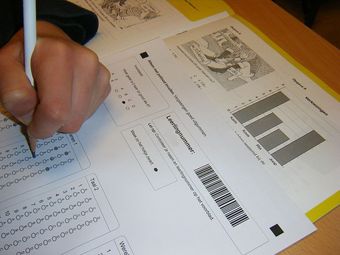
Multiple Choice Test
Some standardized testing uses multiple-choice tests, which are relatively inexpensive to score, but any form of assessment can be used.
13.7.7: Gender Bias in the Classroom
Gender-based achievement gaps suggest the existence of gender bias in the classroom.
Learning Objective
Analyze both the possible root causes of gender-based achievement gaps and its proposed solutions
Key Points
- Boys outscore girls on most high-stakes tests, including both the math and verbal sections of the SAT.
- Girls may receive negative attention bias from teachers, though much of it may be unintentional.
- Teachers may reinforce gender bias when they give more attention to boys or excuse boys’ behavior with the excuse that “boys will be boys.”
- Single-sex classrooms have been proposed as a solution to gender bias.
- Despite evidence of gender bias, girls outperform boys in reading and writing and have made steady gains in career access.
Key Terms
- gender bias
-
A prejudicial stance towards males or females
- achievement gap
-
The observed and persistent disparity between the performance of groups of students defined by gender, race/ethnicity and socioeconomic status, based on a number of educational measures.
- The SAT
-
SAT Reasoning Test (formerly Scholastic Aptitude Test and Scholastic Assessment Test): a national exam taken annually by high school juniors and seniors.
Example
- Teachers may reinforce gender bias simply by drawing distinctions between boys and girls. For example, lining up students or seating them by gender affirms the idea that boys and girls should be treated differently.
Gender-based achievement gaps (especially in math and science) suggest the existence of gender bias in the classroom.
Although most people would like to believe gender bias in the classroom is no longer a problem, evidence points to a persistent achievement gap between boys and girls. Although girls tend to stay in school longer, have better attendance records, and earn better report card grades, boys outscore girls on most high-stakes tests, including both the math and verbal sections of the SAT. Men also outscore women on standardized tests for graduate school, law school, and medical school.
Dissecting Classroom Gender Bias
If test score gaps are evidence of gender bias, where does that gender bias come from? Numerous explanations have been proposed:
- Women and girls may choose to take fewer advanced math or science courses, or they may be discouraged from doing so.
- Cultural norms could influence girls to prepare for their expected role of keeping a home and nurturing children, though such norms are less stringently enforced than in the past.
- Teachers may interact with boys and girls in ways that reinforce gender roles and gender inequality.
Of course, few teachers would admit to bringing gender bias into the classroom, and much of their influence may be unintentional. Nevertheless, teachers may reinforce gender bias when they give more attention to boys or excuse boys’ behavior with the excuse that “boys will be boys. ” Teachers may also reinforce gender bias simply by drawing distinctions between boys and girls. For example, lining up students or seating them by gender affirms the idea that boys and girls should be treated differently. Teachers may also influence students by the way they give praise, encourage a student to correct or expand an answer, criticize, or accept without evaluating a response. Research suggests teachers are more likely to respond to boys with praise or encouragement, whereas they are more likely to respond to girls by simply accepting or acknowledging a response without evaluating it. Because girls are typically socialized to be quiet and passive, teachers may need to actively encourage their participation in class in order to avoid boy-dominated discussion, or a situation in which boys receive more feedback from and interaction with teachers because they more actively participate in class.
One proposed solution to gender bias in the classroom is to separate boys and girls in single-sex classrooms. Theoretically, single-sex classrooms would help students focus without distracting interactions with children of the opposite gender. They could also decrease pressure on girls who feel nervous participating in boy-dominated class discussion. However, empirical studies give mixed evidence as to the efficacy of single-sex schooling, and critics worry that it constitutes a separate-but-equal form of discrimination.
Career Access
Despite evidence of gender bias, female career access has made steady gains in recent years, due largely to the women’s rights movement. More women are now able to work outside the home; although some may be driven to work not as an expression of liberty or equality, but out of economic necessity. Still, women earn only about 75 cents for every dollar earned by men, and many work in low status, sex-stereotyped occupations. In part, that may be due to the college majors women choose. But why, one might ask, would women be more likely to choose college majors that will not benefit them in careers? Sociologists would point to social influences and cultural expectations.
The “Boy Code”
Further, though most research and debate about gender bias in the classroom focuses on bias against girls, recent evidence suggests that boys may be falling behind girls, especially in literacy. In fact, the latest national test scores, collected by the National Assessment of Educational Progress, show that girls have met or exceeded the reading performance of boys at all age levels; by fourth grade, boys have fallen two years behind girls in their reading and writing skills. The male literacy gap has been attributed to sex-based differences in brain function as well as to social factors like the expectations set by an unwritten “boy code” to discourages boys from expressing emotions. This boy code may make male students less likely to share opinions about literature or express frustrations or difficulties to teachers. Thus, just as social pressures may convince some girls they cannot excel at science or math, social pressures may convince some boys they cannot succeed in reading and writing.
The gendering of school subjects may, in itself, lead to gender bias in the classroom, and, further down the line, gender inequality in the workforce.
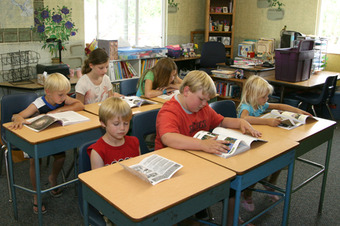
Children in a Classroom
Boys and girls learn together in a classroom.
13.7.8: The Gifted
There is no standard definition of “gifted,” nor a standard way of implementing gifted education.
Learning Objective
List the various forms of education for the gifted and the controversies around gifted education
Key Points
- Common forms of education for the gifted have included acceleration, pull-out, cluster grouping and summer enrichment.
- According to the 1972 Marland Report, gifted youth are more likely than average to experience academic failure and develop social and emotional problems.
- Gifted education received federal support during the Cold War, but that support has recently been eroded.
- Controversies exist over the appropriateness of different forms of gifted education and their emotional effects on students.
Key Terms
- cluster grouping
-
Cluster grouping is the gathering of four to six gifted and talented or high achieving students in a single classroom for the entire school day.
- gifted
-
Endowed with special, in particular intellectual, abilities.
- pull-out
-
Gifted students are pulled out of a heterogeneous classroom to spend a portion of their time in a gifted class.
Examples
- The 2002 No Child Left Behind law shifted attention away from gifted students.
- Most recently, the 2002 No Child Left Behind law has shifted attention away from gifted students
Though gifted education programs are widespread, there is no standard definition of “gifted,” nor a standard way of implementing gifted education. Gifted education programs are justified by a two-pronged argument: First, gifted and talented youth are not adequately challenged by the standard curriculum and therefore require accelerated curricula or enrichment activities to reach their full potential. Second, gifted and talented youth are inherently at-risk.
This second argument may seem counter-intuitive, but it has gained general credibility. This argument was formally articulated by the 1972 Marland Report by then U.S. Commissioner of Education S. P. Marland. According to the report, gifted youth are more likely than average to experience academic failure and to develop social and emotional problems. Gifted students may experience social rejection and difficulty making friends, as well as grapple with fear of failure and perfectionism. They may intentionally play down their abilities in order to make friends. They are also more prone to depression, anxiety and disengagement, as well as to behavior problems and drug and alcohol abuse. This may be in part due to a need for stimulation beyond what they receive in a typical classroom.
Since the early 20th century, definitions of “gifted” have been based on IQ, or intelligence quotient. Different schools may set different cut-offs for defining giftedness, but a common standard is the top 2% of students with an IQ score of about 140 or above. More general definitions of giftedness may also evaluate students’ capability in areas like intellectual, creative, artistic, or leadership capacity, or in specific academic fields. Evaluations may be based on portfolios of student work, classroom observations, and achievement measures.
The 2002 No Child Left Behind law shifted attention away from gifted students. The law aims to bring proficiency of all students to grade level, but critics note it does not address the needs of gifted students who perform above grade level. The act imposes punishments on schools, administrators and teachers when students do not achieve to the plan’s designs, but does not address any achievement standards for high functioning students. This forces schools and teachers to spend their time with low achieving students. As a result of this law, many fear, gifted services have been eroding
Forms of Gifted Education
Gifted education programs take many forms, including a combination of acceleration, pull-out or cluster grouping, and enrichment activities . Acceleration programs may compact curriculum or allow students to self-pace. In compacting, students are pre-tested to determine which skills or content they have already mastered, thus allowing students to skip repetitive practice. This reduces boredom and frees time to work on more challenging material. In self-pacing, students advance at their own speeds. In general, acceleration programs advance students to higher-level material suited to their abilities and preparedness – students may skip grades, skip ahead in particular subjects, or enroll at local community colleges.

Gifted Class
Laura Bush listens to a student talk about sea turtles during a 2006 visit to Banyan Elementary School in Miami, FL, in support of education about parks and the environment.
An alternative to acceleration is pull-out or cluster grouping, in which gifted students are removed from regular classrooms. In pull-out programs, gifted students spend most of the school day with a regular classroom of mixed abilities, but may be pulled out for an hour or part of a day to practice critical thinking drills, creative exercises, or subjects not introduced in standard curriculums. Pull-out programs are generally ineffective at promoting academic achievement since they do not align with the regular curriculum.
Finally, summer enrichment presents gifted students with extra material above and beyond the standard curriculum. Students spend school days with a regular classroom, but also complete enrichment activities given as a modified assignment by the regular classroom teacher. These could include formal programs like Odyssey of the Mind or academic competitions like National History Day. Summer enrichment programs typically operate like summer camps, as students pay a fee to attend and may enroll in programs that typically focus on one subject. In any case, enrichment work is done in addition to regular school work.
Controversy
Controversies concerning gifted education are varied and often highly politicized. They are as basic as agreeing upon the appropriateness of the term “gifted” or the definition of “giftedness. ” For example, does “giftedness” refer to performance or potential? Many students do not exhibit both at the same time. Measures of general intelligence also remain controversial. Early IQ tests were notorious for producing higher IQ scores for privileged races and classes and lower scores for disadvantaged subgroups. Although IQ tests have changed substantially over the past half century, and many objections to the early tests have been addressed by “culture neutral,” IQ testing remains controversial.

Illinois Mathematics and Science Academy
Schools like the Illinois Mathematics and Science Academy cater to the needs of gifted students.
13.7.9: Educational Reform in the U.S.
Education reforms aim at redressing some societal ills, such as gender-, and class-based inequities, or instructional ineffectiveness.
Learning Objective
Outline the main motivations for educational reform and the timeline of its various manifestations
Key Points
- Educational reform has been closely tied to efforts to promote democracy.
- Another motivation for reform is the desire to address socioeconomic problems, such as health, wealth and well being, which many people see as having roots in unequal access to education.
- In the 1980s, conservative reformers tried to limit federal involvement in education, and E.D. Hirsch argued education must teach cultural literacy.
- In the 1990s and 2000s, reformers pushed for outcomes-based education with an emphasis on assessment.
- Teachers’ unions are considered by many to be the major barrier to continued reform.
- Persistent issues in educational reform include school funding, school choice, and alternatives to public education.
- Teachers’ unions are considered by many to be the major barrier to continued reform.
Key Terms
- cultural literacy
-
Knowledge of and ability to discuss the history of and major concepts underlying a culture, particularly one’s own and those of one’s peers.
- school choice
-
School choice is a term used to describe a wide array of programs aimed at giving families the opportunity to choose the school their children will attend.
- outcomes-based education
-
Outcome-based education (OBE) is a student-centered learning philosophy that focuses on empirically measuring student performance, which are called outcomes. OBE contrasts with traditional education, which primarily focuses on the resources that are available to the student, which are called inputs.
Examples
- Critics counter that even within a country, districts with the highest levels of funding do not always have the highest achievement levels. For example, in 2007, the Washington, D.C. public school district had the third highest level of funding per student among the 100 biggest school districts. Despite this high level of funding, the school district provides outcomes that are lower than the national average.
- Critics counter that even within a country, districts with the highest levels of funding do not always have the highest achievement levels. For example, in 2007, the Washington, D.C. public school district had the third highest level of funding per student among the 100 biggest school districts. Despite this high level of funding, the school district provides outcomes that are lower than the national average.
Education reform has been pursued for a variety of specific reasons, but, generally, most reforms aim at redressing some societal ills, such as poverty-, gender-, or class-based inequities, or perceived ineffectiveness.
The idea that all children should be provided with a high level of education is a relatively recent idea, and has arisen largely in the context of Western democracy in the twentieth century. In fact, educational reform has been closely tied to efforts to promote democracy. Many students of democracy desire to improve education in order to improve the quality of governance in democratic societies. The necessity of good public education follows logically if one believes that the quality of democratic governance depends on the ability of citizens to make informed, intelligent choices, and education can improve these abilities. In the United States, for example, democratic education was promoted by Thomas Jefferson, who advocated ambitious reforms for public schooling in Virginia.
Another motivation for reform is the desire to address socioeconomic problems, which many people see as having roots in unequal access to education. Starting in the twentieth century, people have attempted to argue that small improvements in education can have large returns in such areas as health, wealth and well being. For example, in developing countries, increases in women’s literacy rates were correlated with increases in women’s health, and increasing primary education was correlated with increasing farming efficiencies and income. Even in developed countries, an individual’s level of education may predict the type of career and level of income that person can expect to achieve.
Other education reforms have been motivated by attempts to improve the effectiveness of instruction. Many modern reforms have attempted to move away from a model of education in which a teacher lectures and delivers facts to a passive student audience. For example, M. Montessori argued that education must take into account the individual needs of each child. John Dewey suggested that effective education poses problems and puzzles that motivate children to learn.
Over the years, education reform has focused on different goals. From the 1950s to the 1970s, many of the proposed and implemented reforms in U.S. education stemmed from the Civil Rights Movement and related trends; examples include ending racial segregation and busing for the purpose of desegregation, affirmative action, and banning of school prayer. In general, these reforms gave more students from more diverse backgrounds access to education.
In the 1980s, the momentum of education reform moved from the left to the right. For example, E.D. Hirsch put forth an influential attack on progressive education. He argued that progressive education failed to teach “cultural literacy,” the facts, phrases, and texts that Hirsch asserted every American had once known and were still essential for decoding basic texts and maintaining communication. Hirsch’s ideas remain significant through the 1990s and into the twenty-first century and are incorporated into classroom practice through textbooks and curricula published under his own imprint.
In the 1990s, most states and districts adopted Outcome-Based Education (OBE) in some form or another. Under OBE, a state would create a committee to adopt standards and choose a quantitative instrument (often, a standardized test) to assess whether the students knew the required content or could perform the required tasks. During this period, the U.S. Congress also set the standards-based National Education Goals (Goals 2000). Many of these goals were based on the principles of outcomes-based education, and not all of the goals were attained by the year 2000 as was intended. The standards-based reform movement culminated in the No Child Left Behind Act of 2001. In general, OBE reforms attempt to increase accountability in education. Rather than reforming the educational process, they focus on the effects that process achieves by measuring outcomes (e.g., student achievement).
A central issue for educational reform advocates today is school choice. Debates over school choice focus on advocates’ claim that school choice can promote excellence in education through competition. A highly competitive “market” for schools would eliminate the need to otherwise enforce accountability from the top down. According to advocates, schools would naturally regulate themselves and attempt to raise standards in order to attract students. Most proposals for school choice call for vouchers. Public education vouchers would permit guardians to select and pay any school, public or private, with public funds currently allocated to local public schools. In theory, children’s guardians will naturally shop for the best schools, much as is already done at the college level.
Many attribute the purportedly slow pace of reform in the United States to the strength of teachers’ unions. In some school districts, labor agreements with teachers’ unions may restrict the ability of school systems to implement merit pay and other reforms. In general, union contracts are more restrictive in districts with high concentrations of poor and minority students.

Education Segregation in the U.S. Prior to Brown v. Board of Education
Educational reforms during the 1950s, 1960s, and 1970s focused on civil rights, especially desegregation and affirmative action.
